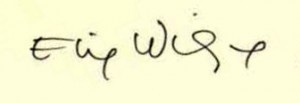Posts Tagged ‘Buchenwald liberation’
Tuesday, June 11th, 2013
[Continuation from “Is it time to call Ken Waltzer a fraud?“]
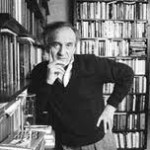 by Carolyn Yeager
by Carolyn Yeager
copyright 2013 carolyn yeager [last updated 12-5-2015]
“In literature, Rebbe, certain things are true though they didn’t happen, while others are not, even if they did.” –Elie Wiesel speaking of his book Night, from his Memoir: All Rivers Run to the Sea
For the skeptics and know-nothings who have written in suggesting Eli Wiesel was not in the camps, that Night is purely fiction, you are all dead wrong. The Red Cross International Tracing Service Archives documents for Lazar Wiesel and his father prove beyond any doubt that Lazar and his father arrived from Buna to Buchenwald January 26, 1945, that his father soon died a few days later. –Kenneth Waltzer in a comment at Scrapbookpages Blog, March 6, 2010.
The story that Michigan State University history professor Kenneth Waltzer has told us about Elie Wiesel in Buchenwald, based on Wiesel’s book Night, is not true.1
Elie Wiesel was not incarcerated at Buchenwald.
He was not liberated from Buchenwald.
He was not a victim of the “Nazis” there.
How do we know that?
Well, how do we know that Elie Wiesel was at Buchenwald?
1. We have a numerical file (registration) card for Lazar Wiesel from Sighet, born 1913.
2. We have a questionaire (Fragebogen) made out for and signed by a Lázár Wiesel, a 16-year old Jew from Sighet.
3. We have a transport list from Buchenwald to France with the name Lazar Wiesel, born Oct. 4, 1928.
4. We see a picture of him in the famous photograph taken in Barracks #56 on April 16, 1945.
5. We have a death report for Abraham Viezel (not Schlomo or Solomon) on 2-2-1945, in Block 57.
6. We have a transport list from Auschwitz to Buchenwald with the names Lazar Wiesel, #123565, born 4 September 1913 and Abram Viezel, #123488, born 10 October 1900.
7. We have a photo of the “rescued children” marching out of the Buchenwald main gate on April 27, 1945.
8. We have the book Night, in which he says he was.
* * *
The above list is ordered according to its perceived importance in proving Wiesel was at Buchenwald, so I’ll start from the bottom (least important) in showing that they don’t prove any such thing.
8. The persuasiveness of the book Night has been dealt with in several other places, for example here and here, and is not considered evidence.
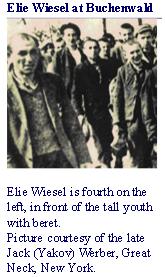 7. Photo of Buchenwald Boys (scroll down a bit). The boy that Ken Waltzer has identified as Elie Wiesel (who was identified to him as such by Jack Werber of Great Neck, NY, a “holocaust survivor” activist) is clearly not Wiesel and has not been identified as Wiesel by anyone other than Ken Waltzer. Waltzer had this image/blurb, at right, on his MSU website for years [the site was removed sometime in 2012], making him look foolish. Will Waltzer admit that he was wrong all this time, or try to sweep it under the proverbial rug?
7. Photo of Buchenwald Boys (scroll down a bit). The boy that Ken Waltzer has identified as Elie Wiesel (who was identified to him as such by Jack Werber of Great Neck, NY, a “holocaust survivor” activist) is clearly not Wiesel and has not been identified as Wiesel by anyone other than Ken Waltzer. Waltzer had this image/blurb, at right, on his MSU website for years [the site was removed sometime in 2012], making him look foolish. Will Waltzer admit that he was wrong all this time, or try to sweep it under the proverbial rug?
6. The Transport List to Buchenwald only proves that Lazar Wiesel, age 31 (a locksmith by trade) and Abram Viesel, age 44, arrived at Buchenwald on January 26, 1945 from Auschwitz. See here and here. Elie’s father’s name was Solomon (Schlomo); he never went by Abram, nor did Elie ever go by “Lazar.” Lazar had been given the Buchenwald number 123565, while Abram had 123488. There is no honest way to turn these two into Eliezer Wiesel and his father. Both the birth dates and the names are wrong. It only proves that Elie Wiesel claimed for himself the Auschwitz prisoner number (A7713) of another man. Where is the tattoo on Elie’s arm that reads A7713?
5. The Death Report for Abraham Viezel, Buchenwald prisoner number 123488, same as on the transport list. His death is recorded as taking place in Block 57 on February 2, 1945, not Jan. 29, 1945 as is clearly stated in Night for Eliezer’s father.2
4. The Famous Liberation Photo taken at Buchenwald on April 16, 1945 is said to show Elie Wiesel among the men in the bunks. Beside the fact that the face pointed out as Elie’s doesn’t look like him (for reasons which have been made clear here and here) and that he did not identify himself in it until 1983 when the campaign to get him a Nobel Prize began, there is also his hospitalization which began on April 14th.3 He could not have been near death in a hospital and in the picture at the same time! Ken Waltzer took the liberty of changing the date the photo was taken to April 12 or 13th to get around that inconvenient fact.4
3. The Transport List to France. When did Elie Wiesel’s birthday change to Oct. 4th from Sept. 30th? A majority of boys on this list share the birth year of 1928. The person listed as Lazar Wiesel is the same Lazar Wiesel that the Questionaire refers to, but we have determined that this person could not have been Elie Wiesel. It is true that Elie Wiesel went to France, but how he got there, and when, is not clear.
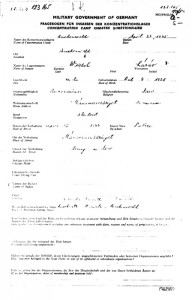 2. The Questionaire [scroll down page] was apparently prepared for and signed by every prisoner prior to their release. It is dated April 22, 1945; the prisoner number is 123165, different by one digit from our previous Lazar Wiesel #123565, and is the number belonging to a recently deceased inmate, Pavel Kun,5 whose death is recorded as March 8, 1945. Since Elie Wiesel allegedly received his number upon arrival on Jan. 26, 1945, he would not later be given a new number from a prisoner who just died. It would seem from this that Lázár Wiesel is a newcomer-of-sorts who had been given a number that had just been released.
2. The Questionaire [scroll down page] was apparently prepared for and signed by every prisoner prior to their release. It is dated April 22, 1945; the prisoner number is 123165, different by one digit from our previous Lazar Wiesel #123565, and is the number belonging to a recently deceased inmate, Pavel Kun,5 whose death is recorded as March 8, 1945. Since Elie Wiesel allegedly received his number upon arrival on Jan. 26, 1945, he would not later be given a new number from a prisoner who just died. It would seem from this that Lázár Wiesel is a newcomer-of-sorts who had been given a number that had just been released.
The name Lázár is spelled with distinct, heavy accent marks; the birth date given is Oct. 4, 1928 (Elie’s is Sept. 30); date of arrest is April 16, 1944 (Elie’s family’s deportation was at the end of May/early June – see here); the signature on the back does not match Elie Wiesel’s known signature or handwriting. The signature is also written with accents over the a’s in Lázár, implying that the accenting originated with Lázár and not with the official who filled out the form.6
But, beyond all this, on April 22 Elie Wiesel, by his own account, was in a hospital in or near Buchenwald camp “hanging between life and death” after coming down with severe food poisoning. He was taken to the hospital on April 14 and not released until April 28, according to his own words in his “autobiographical” Night and his 1995 memoir All Rivers Run to the Sea. Therefore, he could not have been interviewed or signed the questionaire on April 22nd. (See Endnote 3)
1. The Numerical File Card (below), made out at registration, is for Lazar Wiesel from Maromarossziget, born Sept. 4, 1913, making him at the time 31 years old. His Buchenwald prisoner number 123565 is written on the upper right. The card indicates his father, Szalamo Wiesel, was also at Buchenwald, while his mother, Serena Wiesel, nee Feig was currently interned at KL Auschwitz (at the time of Jan. 26, 1945).
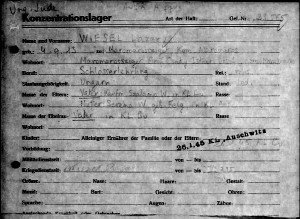 This registration card is the only item that casts some doubt7 over Nikolaus Grüner’s account of Lazar and Abram. But it does not prove that this Lazar Wiesel is Elie Wiesel. It does not make any sense that all the birth dates for the same person would be different! It makes more sense that there were several persons with similar names.
This registration card is the only item that casts some doubt7 over Nikolaus Grüner’s account of Lazar and Abram. But it does not prove that this Lazar Wiesel is Elie Wiesel. It does not make any sense that all the birth dates for the same person would be different! It makes more sense that there were several persons with similar names.
Note that this card identifies Lazar Wiesel as a locksmith (Schlosserfehrling), a trade of which the 15-year-old Elie Wiesel never would have identified himself. In Night he identified himself upon entry to Auschwitz as “a farmer” (p. 32, MW translation) and continued not to boast of any skill (of which he had none anyway) so as not to be sent out for work.
* * *
So we end up realizing there is no evidence that Elie Wiesel ever set foot in Buchenwald in 1945. What’s more, he and others (including Ken Waltzer) have actively and knowingly lied about photographs, dates, times, names, etc. This has gone on with the blessing and support of Yad Vashem Holocaust Memorial in Israel, the US Holocaust Memorial Museum in Washington DC, the New York Times Company, Associated Press, and other establishment media – and the multitude of Jewish/Holocaust-promoting organizations across the globe. Think of Elie Wiesel conducting US President Obama and German Chancellor Merkel around the Buchenwald Memorial in 2009! It is a giant criminal conspiracy when one really takes a look at it. The ramifications are immense.
Someone, preferably Elie Wiesel, needs to explain all the discrepancies in his tale. He has never offered to and never been asked to. If Wiesel won’t attempt an explanation, then Ken Waltzer the Historian with the PhD from Harvard University must do so. In his scholarly studies, Waltzer includes Elie Wiesel as one of the “Rescued Children of Buchenwald. ” One duty of a scholar is to answer serious and justified questions about their work. Elie Wiesel Cons The World is asking such questions and so we await an answer.
Update 6-15 Great idea from a reader: Write to Prof. Ken Waltzer at [email protected] and ask him politely to answer the questions raised in this article.
Endnotes:
1. Prof. Kenneth Waltzer has removed this article from the Internet, along with his entire website which the article had been a part of for several years, and says he has written a new separate article on Elie Wiesel in Buchenwald.
The book is on track, and I have also completed a separate essay to be published on Elie Wiesel and Buchenwald. -Ken Waltzer to me, Carolyn Yeager, in an email, March 2013
He obviously doesn’t want comparisons made between his old and new article and is waiting as long as possible to make it public. Or is he still reworking it?
2. “Then I had to go to sleep. I climbed into my bunk, above my father, who was still alive. The date was January 28, 1945. I woke up at dawn on January 29. On my father’s cot there lay another sick person. They must have taken him away before daybreak and taken him to the crematorium.” –Night, 2006 Marion Wiesel translation, p. 112
The Yiddish original, Un di Velt Hot Gesvign, says Father’s death occurs on the 18-19 of Shevat:
For a couple of hours I stayed by him and looked at his face long and well […] Then they forced me to go lie down to sleep. I climbed up to the uppermost bunk and I did not know that in the morning, on awakening, I would find my father no more.
It was the eighteenth of Shevat, 5705.
Nineteenth of Shevat. Early in the morning.
I got up and ran to my father. Another sick man was lying in his place.
I had a father no more. (p 238)
Readers might be surprised to learn that the Hebrew calendar date of 18-19 Shevat, 5705 corresponds to February 1-2, 1945. This gives credence to the idea that Abram Viezel’s death is the model for the story And The World Remained Silent. The date in the original story for Father’s death and the date of Buchenwald records for Abram’s death concur. This leads me to question Elie Wiesel’s personal knowledge of events at Buchenwald because why would he change the date to Jan. 28-29 if he knew the significance of Feb. 1-2?
Also, the death took place in Block 57, the report said, which would seem to be next door to Block 56 where the famous Buchenwald liberation photo is said to have been taken.
3. “Three days after the liberation of Buchenwald, I became very ill: some form of food poisoning. I was transferred to a hospital and spent two weeks between life and death.” –Night, 2006 Marion Wiesel translation, p. 118
Also in Un di Velt Hot Gesvign (the original Yiddish story from which Night was taken), p.244:
“Three days after liberation I became very ill; food-poisoning. They took me to the hospital and the doctors said that I was gone. For two weeks I lay in the hospital between life and death. My situation grew worse from day to day.”
Another question that occurs is: Of all the photos taken in Buchenwald after liberation, why don’t we find even a single one with Elie Wiesel in it? Knowing he wasn’t there at all may be why he liked the food poisoning/hospitalization story – it can explain why he doesn’t show up in any photograps. But it totally contradicts his “evidence” of the Questionaire and of his being in the famous barracks #56 photo.
4. Waltzer wrote in his article:
“He [Elie] was too weak at liberation on April 11 to leave his barracks (hence he was photographed in a famous picture in the barracks on April 12 or 13), and he came to understand he was free only days later.”
Waltzer trapped himself again. The officially declared date of the photo is April 16, which is well established. Waltzer is simply trying to evade with lies the serious problem of Wiesel going into the hospital 2 days before the photo was taken. This is NOT how a respectable, responsible historian does things.
In addition, Waltzer is saying that the photograph was taken in the children’s barracks #66, which is utterly wrong. The official description says it was barracks #56, for men, or possibly a sick barracks. If Abram Viezel was in a sick barracks when he died (#57), then #56 might also be an “infirmary” barracks.
5. Pavel Kun is on the transport list of Jan. 26, 1945 from Auschwitz to Buchenwald. He appears under the section Politische Slowakan Juden; his birth date is July 6, 1926, making him 18 when he died.
6. Revisionist Carlo Mattogno concluded, after studying these documents, that Lazar Wiesel, Lázár Wiesel and Elie Wiesel are not the same person.
In conclusion, we can say that Elie Wiesel can be neither Lazar Wiesel, nor Lázár Wiesel, nor Lazar Vizel and that the ID number A-7713 was not assigned to him but to Lazar Wiesel, while ID A-7712 was not assigned to his father but to Abram (or Abraham) Viesel (or Wiesel).
The charge of identity theft raised against Elie Wiesel by Miklos Grüner does not concern Lazar Wiesel only, but Lázár Wiesel as well: from the former, he took the Auschwitz ID number (A-7713), from the latter the stay at Buchenwald and the later transfer to Paris. –http://revblog.codoh.com/2010/03/elie-wiesel-new-documents/#more-837
7. Szalamo seems likely a Hungarian spelling for Shlomo. Serena Feig is close but not Elie’s mother’s name, which was Sarah Feig. According to this card, Lazar had a father in the camp, something that was not mentioned by Nikolaus Grüner. Ken Waltzer will say this proves that Lazar Wiesel is Elie Wiesel, but what about the very wrong birthdate? Why don’t we have a card for Szalamo too? These cards are kept at Bad Arolson, not at the Buchenwald Memorial Museum Archive; only people with special permission (like Waltzer) have access to them.
17 Comments
Category Featured | Tags: Tags: Abramham Viezel, Buchenwald Boys, Buchenwald liberation, Elie Wiesel. Buchenwald Concentration Camp, Kenneth Waltzer, Lazar Wiesel, Night, Rescued Children of Buchenwald,
Social Networks: Facebook, Twitter, Google Bookmarks, del.icio.us, StumbleUpon, Digg, Reddit, Posterous.
Sunday, April 14th, 2013
By Carolyn Yeager
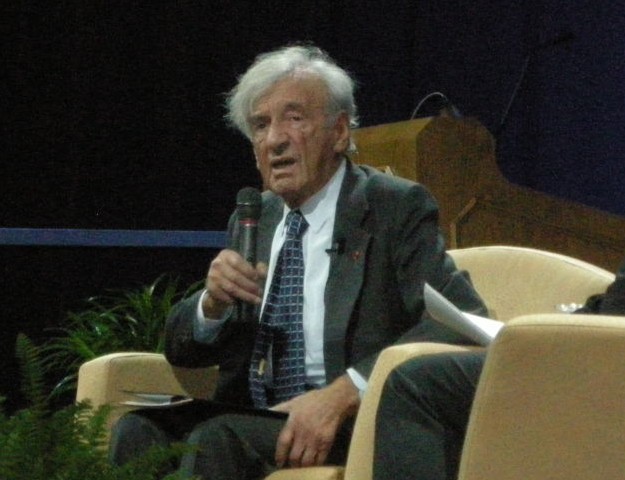
Elie Wiesel in the Kent State Univ. auditorium. Photo by Bob Jacobs
Wiesel demonstrates he has nothing to say to the world when the only news outlet to write anything at all about his speech is the Cleveland Jewish News.
This much-ballyhooed return visit to Kent State University on the April 11 anniversary of the “Buchenwald Liberation” in 1945 proved to be as “much ado about nothing” as the earlier event 68 years ago really was in retrospect.
Wiesel, 83, looking tiny and munchkin-like sitting in a big yellow chair on the stage, uttered the same phrases we’ve heard for decades and they are sounding more hollow than ever. At kentwired.com, [www.kentwired.com/latest_updates/article_25df8c65-c166-57b2-9a99-b89175cd7a3c.html] a University website, we find this summing up of the speech:
One of the major themes of Wiesel’s speech was the importance of having hope and his struggle with believing there is such a thing.
“Where there is no hope, our road and our path is to invent it,” Wiesel said. “I am here to teach you my hope because without it, I wouldn’t be here today.”
Invent it. That’s what Wiesel is good at: inventing things. He offered other similar thoughts that Kentwired considered worthy of quoting but are, in my opinion, devoid of any relevance when pondered for a few seconds, such as:
“For every word that a holocaust survivor writes, there are 10 more that haven’t been written,” said Wiesel. “Whoever listens to a witness becomes a witness.”
My comment on the first sentence: This is true of everyone’s written words. On the second: This well-worn phrase of his might be what is engraved on his tombstone – he has used it so often. Of his supposed liberation by U.S. soldiers at Buchenwald, he said:
We had lost every concept of how to feel. We did not know what it was like to be free.
“I believe in the virtue of gratitude,” Wiesel said. “Simply to say to each other, thank you.”
The first is patently false. It discounts all the uprisings that supposedly took place, all the resistance activity in the camps, and the fact that Wiesel only claims to be a detainee for one year. One doesn’t lose memory of freedom in one year. The second bit of wisdom takes care of not answering questions about Buchenwald nicely, doesn’t it.
At the Cleveland Jewish News (CJN), reporter Carlo Wolff ([email protected]) tries to build up the importance of Wiesel’s utterances by writing that he “delivered a lesson in history, literature, philosophy and morality, demonstrating his didactic prowess and his belief in the power of continuity.” I must not be intelligent enough to grasp the greatness of this speech, which Wolff tells us was appreciated by “a rapt, sell-out audience of 5000” … mostly fellow Jews, I would say. I’m convinced that Jews from all around the broader area drove to Kent to see, hear and support one of their own, who has always fought for Jewish and Israeli interests.
No one noticed Wiesel’s mic was off for first 20 minutes
But Wolff had enough of the journalist in him to tell us about the following screw-up that must have embarrassed Kent State President Lester Lefton, also a Jew and the man who invited Wiesel to the campus.
The first 20 minutes of Wiesel’s April 11 talk almost fell on deaf ears because his microphone wasn’t turned up; most followed his eloquent words as they scrolled out on giant screens flanking the stage.
According to Wolff, Wiesel didn’t refrain from his familiar finger-pointing at the Germans.
He remains appalled by the Nazis. “The enemy managed to push its crimes beyond language,” he said, explaining the difficulty he has (and the obsessions that dog him) in telling a story that can never ultimately be told.
“They had education. They had degrees. So what happened?”
What happened? Their education helped them see clearly that Jews were a danger to their German social order – and so they were, and are. It is really only Jews who commit crimes “beyond language,” if such a thing exists. It is Jews in Israel that force pornography into Palestinian homes via their television sets, at the same time they are attacking them militarily. Only Jews would dream up something like that. Likewise, only Jews would dream up the kind of concentration camp atrocity stories they tell, atrocities that Germans, Nazi or not, would never think of themselves, and therefore never do.
Tweeting the most pithy remarks of the evening
Kentwired had someone tweeting the highlights of the evening as it progressed. Here is an example of the “best of Elie Wiesel”:
- “My first passport was an American one. It’s still a symbol of human passion,” said Wiesel. “I owe America.”
- “Remember there will always be questions that have no answer,” Wiesel speaking about his experience as a Holocaust survivor.
- “I believe in memory because without it nothing is possible.”
- “The moment we stop remembering, we stop believing.”
- “Could humanity get Alzheimer’s? Could history get Alzheimer’s?”
- “History has gone beyond its limits and therefore forget it no more,” Wiesel says on making sure people don’t forget.
- “The love of children is the purest of all,” says Wiesel on trying to understand why children were killed during holocaust. [Wiesel had one child who grew up to go to work for Goldman Sachs – cy]
The following were probably answers to softball questions from the audience:
- “History has not found balance,” said Wiesel on all the chaos in the world. “We are still waiting for redemption.
- “I simply feel, again, that I have done something,” said Wiesel on his many honors and awards
- “I couldn’t be who I am if not for those books,” said Wiesel on the many books he’s written
Have you had enough? It doesn’t get any better. And it all sounds very similar to Wiesel’s speech last year at Xavier University in Cincinnati, Ohio. To sum up, Wiesel is a fading star who may not last much longer. What can last is the incredible mythology built up around him unless we work very hard to separate reality from nonsense. This takes a consistent effort, not once-in-awhile comments about the same old themes. As we can see, that is actually Wiesel’s style and it’s not very effective. When it comes to the Elie Wiesel myth, it’s the media that has done all the heavy-lifting, not E-lie himself.
This time, even the media didn’t have an appetite for it.
6 Comments
Category Featured | Tags: Tags: Buchenwald liberation, Carlo Wolff, Elie Wiesel, Kent State University, Lester Lefton, Palenstinians,
Social Networks: Facebook, Twitter, Google Bookmarks, del.icio.us, StumbleUpon, Digg, Reddit, Posterous.
Monday, April 1st, 2013
By Carolyn Yeager
copyright 2013 Carolyn Yeager
Updated April 7th
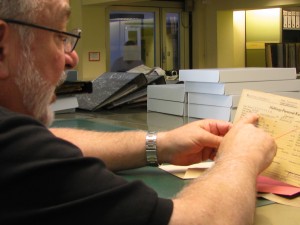
Prof. Kenneth Waltzer is looking at a Buchenwald registration card at the International Tracing Service in Bad Arolsen, Germany.
Kenneth Waltzer is a professor of history at Michigan State University since the early 1970’s. He helped to create the Jewish Studies program which opened in 1992, and which he heads. Waltzer has been researching into evidence of a special ‘boy’s protection program’ run by prisoners at Buchenwald for going on 10 years now. As an “approved” researcher, he is allowed to peruse all the files at the International Tracing Service in Bad Arolsen, Germany, something that is made much more difficult, if not impossible, for revisionists.
Waltzer is considered one of the top scholars in the U.S. of the ill-named holocaust but his work has been sloppy, and his attempts to cover up the sloppiness amount to fraud. This, along with his continual promotion and defense of Elie Wiesel as a Buchenwald survivor, is what has drawn me to study him ever more closely.
Because of the seriousness of the charge I am making against him, I will list right up front my reasons for thinking it is time for such a call. They are:
- Waltzer habitually tells fibs in the form of false information which is intended to mislead. When called out for it, he tells more fibs to cover for the first ones.
- He has been in the service of the “Holocaust Industry,” not academic rigor and fair-mindedness, from the very start of his career.
- He knowingly defrauds his students, his university and the public (you and I) with his dishonest “holocaust scholarship.”
- While he is drawing high pay as a tenured American professor of history at MSU, he is working to advance the State of Israel.
I am going to show that these charges have a strong basis in fact. Fraud is commonly understood as dishonesty calculated for advantage. A person who is dishonest may be called a fraud. In the U.S. legal system, fraud is a specific offense with certain features. (see here)
Legally, fraud must be proved by showing that the defendant’s actions involved five separate elements: (1) a false statement of a material fact, (2) knowledge on the part of the defendant that the statement is untrue, (3) intent on the part of the defendant to deceive the alleged victim, (4) justifiable reliance by the alleged victim on the statement, and (5) injury to the alleged victim as a result.
I am not intending to bring legal charges of fraud against Prof. Waltzer, but to try him in the court of public opinion. Therefore, it will be up to Waltzer to defend himself against my charges.
* * *
Two years ago, I asked the question on this web site: “What happened to Ken Waltzer’s book about the boys of Buchenwald?” It was claimed to be, at that time, in it’s final stages. Eight years after he publicly announced he was researching for a book about the so-called children’s barracks at Buchenwald (Barracks #66 ), it still has not materialized. Five years after his book was described as “upcoming,” it still has not materialized. During this time, he has not produced another book, or any major work that would have taken precedence over this book. So what is the delay?
It’s pretty plain that the book’s thesis has shifted considerably since 2005, when his MSU website featured Elie Wiesel as the most recognizable and famous child survivor from Buchenwald. That website was taken down between one and two years ago and is completely wiped clean from the Internet. The banner on all the six to eight pages that were included showed a photograph very similar to the one below of the “boys” being marched out of the main Buchenwald camp to temporary quarters at the former SS barracks.
The USHMM (national holocaust museum in D.C) website dates this picture as being taken on April 17, 1945, six days after liberation.1 At this time, Elie Wiesel, by his own account in two books, was laying in a hospital sick almost unto death from food poisoning. Details like this don’t deter Prof. Waltzer from backing up in every instance the standard holocaust narrative. “Elie Wiesel in Buchenwald” is the standard narrative, so evidence must be found for it.
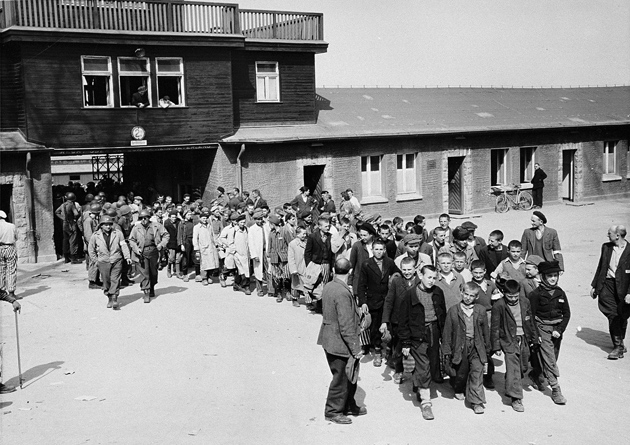 Ken Waltzer claimed for years that one of these boys was Elie Wiesel. But Wiesel is not in this picture!
Ken Waltzer claimed for years that one of these boys was Elie Wiesel. But Wiesel is not in this picture!
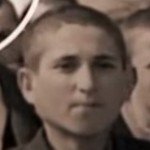 From at least 2005 (eight years now), Waltzer has identified the boy third from the front in the left-side column (dressed in a black suit, bareheaded, and in front of the tall boy wearing a beret) as Elie Wiesel, based on nothing but his own fraudulent intention that there was enough resemblance that people would believe it if he said so. In this article , I exposed this lie. Waltzer has never admitted that he was mistaken or was perpetrating a falsehood that he intended to put into his book. Instead, what he did when his fabrication was sufficiently exposed was to take the entire site down and not mention it again.
From at least 2005 (eight years now), Waltzer has identified the boy third from the front in the left-side column (dressed in a black suit, bareheaded, and in front of the tall boy wearing a beret) as Elie Wiesel, based on nothing but his own fraudulent intention that there was enough resemblance that people would believe it if he said so. In this article , I exposed this lie. Waltzer has never admitted that he was mistaken or was perpetrating a falsehood that he intended to put into his book. Instead, what he did when his fabrication was sufficiently exposed was to take the entire site down and not mention it again.
Left is a close-up of the boy Waltzer has maintained for several years is Elie Wiesel. Anyone can tell it is not and that’s why no one else ever publicly agreed with him.
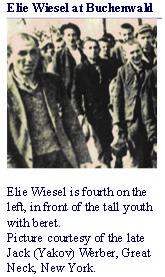 I have some of what was on that site copied into articles here at EWCTW and also in my files. At left is the cropped section of the photo that Waltzer used on the banner of his MSU-Newsroom/Holocaust website that was very much dedicated to Elie Wiesel. (Another reader, Chris, informed me that he had found pages from the site using the Way Back Machine. Many thanks to him.) This shows that Waltzer definitely identified the boy in the black suit as Elie Wiesel. In addition, Jack Werber, a known dishonest survivor, was the supposed supplier of the picture.
I have some of what was on that site copied into articles here at EWCTW and also in my files. At left is the cropped section of the photo that Waltzer used on the banner of his MSU-Newsroom/Holocaust website that was very much dedicated to Elie Wiesel. (Another reader, Chris, informed me that he had found pages from the site using the Way Back Machine. Many thanks to him.) This shows that Waltzer definitely identified the boy in the black suit as Elie Wiesel. In addition, Jack Werber, a known dishonest survivor, was the supposed supplier of the picture.
Below right, a screen shot of one of the pages as it existed then, sent by a friend of EWCTW. It shows more of the emphasis on Elie Wiesel.
When I pointed out much of this in a podcast of March 25th, Waltzer sent me an email on March 28th stating,
My websites at UM FLint are down because I was appointed there one year and am now back at Michigan State.
Of course I never mentioned UM Flint and never even saw his website there. I was speaking about his MSU website, which was titled something like Ken Waltzer’s “MSU Newsroom Special Report.” It was full of information about his projects and especially what he calls “the rescue operation of children at Buchenwald.” It was up on the Net since at least 2008 2, then suddenly disappeared, with not even cache pages to be found. Did Waltzer tell me a fib, or did he just read the podcast program description and misinterpret what it said about “taking down web pages?” By now, he will know what I mean and may answer.
 I think it is very possible that he timed the take-down of his MSU “Newsroom” site with his one-year visiting professorship at UM Flint — putting up a temporary website there which he could take down when he left. This is a way of confusing the picture in order to distract as much as possible from his more recent decision to put more distance between himself and his prior (false) assertions about Elie Wiesel.
I think it is very possible that he timed the take-down of his MSU “Newsroom” site with his one-year visiting professorship at UM Flint — putting up a temporary website there which he could take down when he left. This is a way of confusing the picture in order to distract as much as possible from his more recent decision to put more distance between himself and his prior (false) assertions about Elie Wiesel.
His intention was and is clearly to deceive. The harm is caused to ordinary people who believe and trust that they are getting knowledgeable answers from a professor of history and a holocaust scholar. In this particular case, all five of the elements necessary to prove fraud are there.
First, he sets up a University-sponsored website maintaining falsely that Elie Wiesel is the boy in the photograph of youthful “survivors” marching out of the camp (1). He knows it is false because he has no evidence or proof, only his own “wishful thinking.” The USHMM never identified Wiesel in that group of boys, nor did anyone else (including Wiesel himself), unless they did so from following Waltzer’s example (2). Waltzer’s intent was to make the public believe something that was not true – that he had proof of Elie Wiesel being one of the “rescued children” (3). Because Waltzer is a Professor of History and “holocaust expert” at a major university, and is at all times written up very favorably in the media, the public (you and I ) and his students will rely on his statements (4). These same students and public are injured when photographs are mislabled in order to foist on them a certain belief about an influential historical event that affects their entire world view (5).
* * *
This is just one instance of the untruths that Ken Waltzer has told over the years. Another tactic he uses is to promise an upcoming answer to your doubts which he cannot or does not produce now. As we have seen, we continue to wait as he continues to promise. Still another tactic is to accuse others of lying when it is he who is doing so. But only people who are knowledgeable enough about these complex and purposely obscured issues can see who is doing the lying. In this same email, Waltzer wrote:
The book is on track, and I have also completed a separate essay to be published on Elie Wiesel and Buchenwald.
Completed, he says. And separate. Why separate? I wrote back to him asking where I could find his essay because I wanted to read it. No reply – which is typical because factual information is not his forte, emotional rhetoric is. I feel it’s quite possible, even probable, he wrote a separate essay on Elie Wiesel so as not to tarnish his book with the false “facts” about Wiesel in Buchenwald. He can always get rid of an essay, if necessary, later – but not his entire book. What might there be in this essay? [As it turned out, the book never manifested at all –cy, 4-14-25] Will it be the same or quite different from what he wrote in a March 6, 2010 comment at Scrapbookpages Blog, when he said [my underlining-cy]:
For the skeptics [I was using the screen name “skeptic” then, at Scrapbook blog -cy] and know-nothings who have written in suggesting Eli Wiesel was not in the camps, that Night is purely fiction, you are all dead wrong. The Red Cross International Tracing Service Archives documents for Lazar Wiesel and his father prove beyond any doubt that Lazar and his father arrived from Buna to Buchenwald January 26, 1945, that his father soon died a few days later, and that Lazar Wiesel was then moved to block 66, the children’s block in the little camp in Buchenwald. THese documents are backed up by military interviews with others from Sighet who were also in block 66, and by the list of Buchenwald boys sent thereafter to France. All of this is public domain.
Wishful thinking by Holocaust deniers will not make their fantasies true. While Wiesel took liberties in writing Night as a literary masterpiece, Night is rooted in the foundation of Wiesel’s experience in the camps. The Buchenwald experience, particularly, runs closely to what is related in Night.
Comment by kenwaltzer — November 14, 2010 @ 6:57 am
How much untruth is contained in this, in order to defraud us all in his devoted service to the “Holocaust Industry” and the state of Israel? Plenty. As proof that Elie Wiesel was in Buchenwald, he points to documents for Lazar Wiesel and “his father.” It is even more absurd because Lazar Wiesel’s relative was only 13 years older than Lazar – it was in fact his brother Abram! Waltzer is passing off Lazar for Elie simply on the basis that Lazar also came from Sighet, Elie’s hometown and carries the same name. Sighet was a city of 50,000 or so with a very large Jewish population, and Wiesel was a common name. But the “scholar” who has taken years to research this and still isn’t finished, wants us to believe there can be only one Lazar Wiesel, who is Elie. He attributes the difference in their birthdates to bureaucratic error.
Previously I may have called this stupidity, but now I’m calling it fraud, based on the above-given definition. Of course Waltzer can see the discrepancies here, but he hopes he can convince you not to see them. The Military Interview mentioned with Lázár Wiesel’s name on it also does not have the right birthdate for Elie Wiesel, nor does the signature match Elie’s well-known signature.
Will Waltzer repeat this nonsense in his latest “completed” essay? Notice that Waltzer never fails in the name-calling department, here calling his critics names such as “know-nothings” and “Holocaust deniers.” Several months later, he wrote a similar comment at EWCTW to the blockbuster article: “Signatures Prove Lázár Wiesel is not Elie Wiesel”
by kenwaltzer
On November 14, 2010 at 10:34 am
Contrary to Carolyn Yeager’s wishful thinking, Eli Wiesel was indeed the Lazar Wiesel who was admitted to Buchenwald on January 26, 1945, who was subsequently shifted to block 66, and who was interviewed by military authorities before being permitted to leave Buchenwald to go with other Buchenwald orphans to France. Furthermore, there is not a shadow of a doubt about this, although the Buchenwald records do erroneously contain — on some pieces — the birth date of 1913 rather than 1928. A forthcoming paper resolves the “riddle of Lazar” and indicates that Miklos Gruner’s Stolen Identity is a set of false charges and attack on Wiesel without any foundation.
The promise of a forthcoming paper turned out to be a fib. From Nov. 2010 to now, there has not been any paper. Maybe it’s the essay he mentioned in his March 28th email? “Forthcoming” to Waltzer means up to two and a half years, it seems. That in itself is the sign of an unreliable person.
There can be only one reason Ken Waltzer allows himself to look like a buffoon and a shyster. He doesn’t need to do it to keep his position at Michigan State University. He does it because it is his larger job to keep the Buchenwald atrocity stories and Liberation lies, including the Elie Wiesel myth, alive and well in the mind of the public. He works for purely Jewish interests – I will be writing a future article on the priority, meaning and funding of Jewish Studies programs in American universities. For now, I can add that Waltzer is more of a public relations (PR) worker for the Holocaust Industry, the State of Israel and maybe AIPAC, than he is an honest-to-god academic. Another organization connected to Israel that he serves is Scholars for Peace in the Middle East. He has written four attack-dog articles for them since 2009, functioning in a sort of Abe Foxman-pitbull style.
In Nov. 2009, he attacked Alison Wier as another “know-nothing” because she speaks up for Palestinian rights on college campuses, where she is popular.
In May 2010, he went after John Mearsheimer for calling Israel “an apartheid state” and also took out after Noam Chomsky, Norman Finkelstein, and “the crackpot Phil Weiss.”
Also in May 2010, another target was Judith Butler, who campaigned at the Berkeley campus for the university “to divest from companies making military weapons which Israel employs to commit war crimes.”
In August 2011, he wrote on the Israeli-Palestinian peace process, arguing for Israel’s interests to be well and strongly presented on college campuses.
But this is only the tip of the iceberg when it comes to Walzer’s pro-Israel activities. I will be writing further articles that present the evidence for Ken Waltzer being guilty of fraud in his public writings and during his entire career. Much of it revolves around Elie Wiesel and the Industry’s need to place him at Buchenwald. My position, if you have somehow missed it, is that Elie Wiesel was never at Buchenwald. I am also saying that Waltzer is backing down or “stepping back” from his blatant, dishonest claims about Wiesel, but he can’t back down altogether.
Endnotes:
1. I have also seen it dated April 27 at the USHMM and have used that date in other articles here. Now I have only found this one picture which is very officially dated the 17th. There may have been an attempt to move the date to the 27th so that Wiesel could be in the picture (though he supposedly would not have been released from the hospital until the 28th). It is really too bad the USHMM cannot be relied upon; nor can Yad Vashem. When the museum “researchers” are involved in lying or in complacency, one really has nowhere to turn.
2. http://msutoday.msu.edu/news/2008/mapping-the-holocaust-archive-msu-prof-explores-records-of-nazi-atrocities At bottom of article, it reads “For more information, and to follow Waltzer’s research and read his journal as he participates in the workshop, visit the special report at: http://special.newsroom.msu.edu/holocaust.” This is a link to the website that no longer exists, as you will see if you click it. Now he seems to be pretending it was never there.
11 Comments
Category Featured | Tags: Tags: Abram Vizel, Buchenwald camp, Buchenwald liberation, Elie Wiesel, Holocaust Industry, Israel, Ken Waltzer, Lazar Wiesel, legal definition of fraud, M. Grüner, Michigan State University, Night, Scholars for Peace in the MIddle East, USHMM,
Social Networks: Facebook, Twitter, Google Bookmarks, del.icio.us, StumbleUpon, Digg, Reddit, Posterous.
Saturday, May 19th, 2012
by Carolyn Yeager
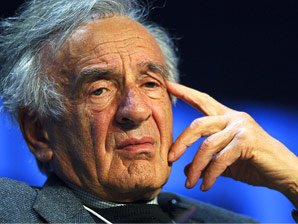
To cry or not to cry, that is the question.
Elie Wiesel, as usual, cannot make up his mind.
On May 6, he gave a major speech (for big bucks) at Xavier University in Cincinnati, brought there by the Center for Holocaust and Humanity Education. A reporter who covered the speech wrote that Wiesel said this:
Wiesel recounted his rescue from the concentration camp by the U.S. Army and said he remains grateful.
“We cried,” he recalled. “We discovered for the first time that we could cry.”
But in an interview that was published on the following day, May 7, on NBC New York, Wiesel said the opposite to reporter Gabe Pressman:
He told me about the day the American army came to liberate the prisoners,
How the prisoners “wanted to cry but they didn’t know how to cry… if you cry, you will never stop so they didn’t even do that.”
So which is it? Did they cry or didn’t they? It seems you get to choose which version you like best.
I pointed out in this article on the Xavier speech that this was the first time I had ever heard or read Elie Wiesel say that he or his barracks-mates cried. Since this Blog takes the position that Wiesel was not even there (in Buchenwald), it’s kind of a mute point–except for the fact that it’s one more reason not to believe he was there. He can’t keep his “story” about it straight.
Wiesel embellished his Buchenwald liberation tale when he was interviewed by Oprah Winfrey, too. As I recounted in this article, he told Oprah in Nov. 2000 that the first thing the religious boys in his barracks did was to “reassemble” and offer prayers for the dead–yet in his books he made a point to say the only thing anyone did was go after the food provisions. He wrote that they had no thought of their families nor of friends, only of food.
The flexibility of memory
Considering all this, we arrive at a crucial question about the Holocaust. The fate of nations may hang on it! What does it mean if Memory, that sacred human ability on which the entire holocaust narrative rests, cannot be depended upon?
Elie Wiesel’s memory is clearly not reliable. Yet he himself has made everything depend on memory. He wrote: “I shall never forget that night, the first night in camp […] never shall I forget those moments … ” and so on. But he must have forgotten some things since his story doesn’t remain consistent.
Memory itself–the act of remembrance–is just not what Elie Wiesel makes it out to be. For Weisel, it’s more like these words he is famous for saying: Some things are true though they didn’t happen, while others are not, even if they did. That is how we tend to remember!
In his case, Elie Wiesel was liberated from Buchenwald, even if he wasn’t … and it’s not true that the prisoners were only interested in food, even if they were. Memory–it’s such a flexible thing.
17 Comments
Category Featured | Tags: Tags: Buchenwald liberation, Elie Wiesel, Holocaust fraud, memory, Oprah Winfrey,
Social Networks: Facebook, Twitter, Google Bookmarks, del.icio.us, StumbleUpon, Digg, Reddit, Posterous.
Thursday, November 24th, 2011
In January, I featured a “Letter of the Week” and said when we got another letter as good as Hailey’s, or almost as good, I would feature it in the same way. Well, Elie Wiesel Cons The World recently received two comments, spaced 2 days apart, that are almost as good as the letter from haileylovespink.
 I’m replying to both of them here. On Nov. 20 Shelby commented on my article Gigantic Fraud Carried out for Wiesel Nobel Prize. She wrote:
I’m replying to both of them here. On Nov. 20 Shelby commented on my article Gigantic Fraud Carried out for Wiesel Nobel Prize. She wrote:
Really people so what he lied about a picture he was still there. Leave him alone. He has been through more in his life than you can ever imagine. So leave it be. Don’t ruin the rest of a mans life cause you are unsatisfied with yours.
This wording has a familiar ring to it, but I won’t speculate about who it might be and just accept it as is. Shelby, you seem to be admitting Wiesel lied about being in the picture (famous Buchenwald liberation photograph), yet you are still sure he was there. Are you fantasizing? Without evidence, you cannot say for sure he was there just because its been assumed all these years.
You also call lying about being in the picture a “so what.” Shelby, it’s not “so what.” This is not just any picture. It happens to be the only “proof” that he was there. Further, it reveals a serious moral failure. Elie Wiesel knows whether he’s in that picture or not; he himself cannot be fooled about it. So you are right, he lied. He lied in order to get a Nobel Prize.
As to what Wiesel “has been through” in his life, he was, according to him, in German custody for one year, from May 1944 to April 1945 … after that, he had everything good done for him. One bad year out of 83 years in all … I’m sure many people would be happy to trade that with him. So your sympathy for someone you don’t know (or do you?), and don’t really know anything about, is wasted and even foolish. As to me being dissatisfied with my own life … well, you don’t know that, do you? I’m happy to report to you that is not the case.
On Nov. 22, Sarah wrote a longer comment about my article New Evidence on Elie Wiesel at Buchenwald. She writes:
this website is truly disgusting, so what if Elie isn’t documented properly within the records, you do realize Nazi’s didn’t bother documenting EVERY SINGLE PERSON to go through each camp, they could care less. Not all records will be accurate, and regardless if Elie did live in Buchenwald or not makes no difference, but why a man who has suffered and endured so much, lie about where he’s been, for every historian or writer who thinks any holocaust survivor is lying about their experinces cannot speak on their behalf because they have not been in same position.
Sarah, you also say “so what” … so what if Wiesel isn’t documented, makes no difference to you. In fact, it even makes no difference whether Elie ever lived in Buchenwald. But if Elie didn’t live in Buchenwald, his entire story is false, Sarah. Can’t you understand that? You are a real believer.
What does make a difference to you appears to be that those who are not holocaust survivors have not been in the same position … therefore we cannot accuse the survivors of lying. Sarah, just like Elie, you fall back on the position that “holocaust survivors” are beyond the understanding, and therefore the criticism, of we ordinary mortals. That is holocaustianity–a belief–not history or science. The doctrine of holocaustianity is: Don’t ask questions; those who ask questions are disgusting unbelievers.
I invite Shelby and Sarah to write again; they are always welcome here. In the meantime, here is an idea for them to consider: Get Mr. Wiesel to show all of us his tattoo that he claims to have on his arm and that will go a long way toward shutting us up.
Update: replies from Sarah and Carolyn
On November 24, 2011 Sarah replied to the above:
Glad you were able to reply back Carolyn, I assumed you would be busy writing more articles on Elie Wisel lying to the public about his experiences. I have read more articles on your website, and you might be surprised to hear that I have a slight change in opinion, yes the tattoo not being where it should be is very strange, but I still don’t believe that calling this man a con is the right way to go about it and yes he could be lying about his experiences, but reading his novels, can you honestly tell me that someone can make all of that up? Can you tell me that you could write a novel like Night, lie about such a tragic experience such as the Holocaust. As I read further on in your articles it disgusts me to see that the many people who comment don’t believe the holocaust ever happened. This is quite ironic actually, Carolyn, you have evidence to prove that Elie Wisel is lying about his time in the concentration camps, and the proof you have is quite substantial, so how is it that with the proof that British soldiers brought from Bergen-Belsen and the numerous photos taken of the prisoners shown to the general public are disregarded and hundreds of testimonies from real survivors are just tossed aside(unless you are going to go on to prove every single survivor is lying and find proof to back that up). In my opinion, that’s real evidence, and yet people continue to deny the holocaust, and your site seems to support that as well, funny, isn’t it. I guess for most people, the truth is hard to swallow, and its easier to deny that millions of people died under the watch of the entire world and nothing was done for years; rather than accept that an entire race was almost abolished because of pure ignorance. Hope to hear from you soon Carolyn, and I read Hailey’s post, and I love her for that, why do you spend so much time trying to prove 1 man wrong, regardless if he’s never even set foot on a camp soil, the Nazi’s had a final plan to kill all Jews, they almost accomplished just that, the Allies took their sweet time getting to these camps and what do people says years later? “It’s a lie, Jewish people just want to hype up German hatred.” “Its all a Holohoax.”
It’s great to see what kind of world we live in………so far I don’t see any sites denying the Rwanda Genocide, so is that what’s next, worldwide denial of that, or can we just refer to all the videos of the dead bodies along the road…..OH WAIT, didn’t we see that in the concentration camps?
On November 25, 2011 Carolyn replied to Sarah:
I welcome the opportunity to discuss with you all that you have brought up. But first I have to chide you for changing the subject. You gave up on defending Elie Wiesel very quickly, but you still don’t want to admit he lies. You admit the tattoo is not where it should be but you leave out that he says it is there. Doesn’t this alone make him something of a con man? What else would you call it? A liar? A mental case? A person who thinks he is above all rules and/or physical laws? Please explain to me why he would say he has an A-7713 tattoo on his arm when the rest of the world can see that he doesn’t. I’ll give you a hint: he is very ambitious; and he knows the Media will never bring it up, will never ask him about it. He knows the all-powerful Media is in the hands of His Friends.
You bring up his novels. How many of his novels have you read? Only Night? You ask if I could write such a novel without being in the camps. The answer is yes because others have done it; quite a few fraudulent concentration camp stories have been uncovered. Almost all holocaust survivor books are half fiction. There is so much literature about the camps out there, all you have to do is read it and then write your own. Also, Night has many un-credible and inaccurate passages (some even copied on the sidebar of this website) that have caused critics to question whether Wiesel was actually there — long before Myklos Grüner came on the scene with documents. In all sincerity, Sarah, I don’t think you could defend the book Night if you had to.
At this point you jump to Bergen-Belsen, since you have not made your case about Wiesel. This is what holocaust believers invariably do. But this website is only about Elie Wiesel. I stick to that so people can’t change the subject on me and go around in circles as you’re doing. It’s clear to me that you realize Elie Wiesel cannot be defended, as many are coming to realize, but you don’t want to talk about it. You say calling Wiesel a con is not the right way to go about it; that yes, he may be lying but his book is so good. This does not make sense. He is or he isn’t. The facts say he is, which you recognize.
You only sound silly, Sarah, because you’re trying to defend the indefensible. So you say to me: “why do you spend so much time trying to prove 1 man wrong, regardless if he’s never even set foot on a camp soil, the Nazi’s had a final plan to kill all Jews, they almost accomplished just that …” If the Nazi’s had such a plan (which has never been discovered) they certainly didn’t come close to killing all Jews. There were more Jews than ever shortly after the war, moving and emigrating all over the world. Real statistics prove it. The world has no shortage of Jews. But to get back to Elie Wiesel, do you admit he is a fraud? Are you really going to argue that whether he is or isn’t, he should be left alone and remain the icon of the Holocaust? Are you that comfortable with dishonesty? Should the Holocaust stand on fraud? These are serious questions you and all Jews should consider.
Further replies follow in the Comments section below.
6 Comments
Category Featured | Tags: Tags: Buchenwald liberation, Elie Wiesel, holocaustianity,
Social Networks: Facebook, Twitter, Google Bookmarks, del.icio.us, StumbleUpon, Digg, Reddit, Posterous.
Monday, September 12th, 2011
By Carolyn Yeager
Proof that the man in the famous Buchenwald photograph is NOT Elie Wiesel.
With the help of the New York Times and the U.S. Holocaust Memorial Museum, Elie Wiesel and his backers did not shy away from criminal deceit by purposely misidentifying an unknown face in this famous photo as belonging to Elie Wiesel.
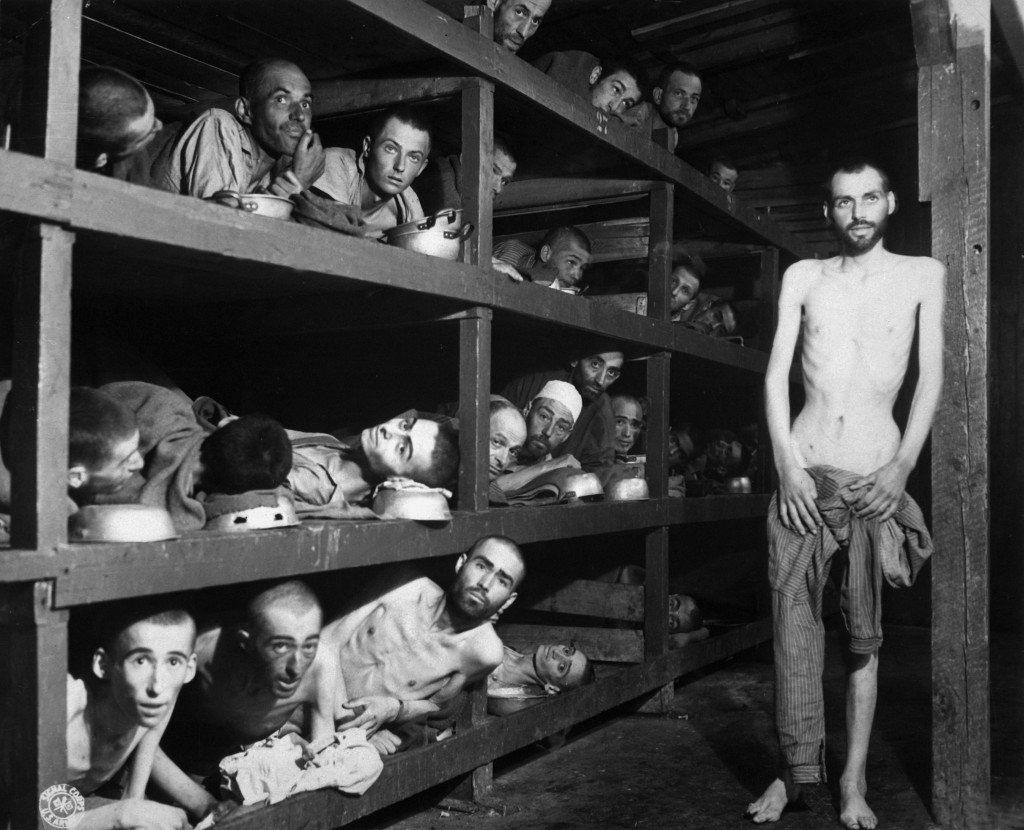
The above high-resolution photograph of Buchenwald survivors was first published in the New York Times on May 6, 1945 with the caption “Crowded Bunks in the Prison Camp at Buchenwald”. [click on image twice to enlarge fully] It was taken inside Block #56 by Private H. Miller of the Civil Affairs Branch of the U.S. Army Signal Corps on April 16, 1945, five days after the Buchenwald camp was liberated by a division of the US Third Army on April 11, 1945. None of the men in the picture were identified at that time.
The U.S. Army photographer was in block #56, not #66
The U.S. Army photographer said he was inside Block #56. The “children’s block” that housed the so-called “boys of Buchenwald” was #66. This was not a typo. Note that these men are not children or teenagers, except for the youngster on the lower left who has been correctly identified as 16 yr. old Myklos (Nikolaus) Grüner, and maybe a couple others. These adults appear to be a mixture of sick individuals suffering from a wasting disease (Grüner learned after liberation he had TB), along with basically healthy men who were also in that block, for some unknown reason, five days after they had been freed. As we have read from many Buchenwald inmates, they moved about at will from the day of liberation onward. In Elie Wiesel’s book Night, he even says that some of the boys in his block went to the city of Weimar the very next day to steal potatoes and rape girls.
The true facts of this photograph have never been told and perhaps are not known. (Grüner has written in Stolen Identity that he left a procession of youths being led to the camp entrance on the morning of April 11, scurried into the nearest barracks and jumped into an empty bunk space. It turned out to be this one.) But because of the man standing there stark naked except for a piece of clothing held in his hands to cover himself, this photograph was certainly staged. In any event, it was never represented as the “children’s barracks.” Still, Elie Wiesel inexplicably once told an interviewer for the German weekly Die Zeit that this photograph was taken in the Children’s Block and all these men were really teenagers even though they looked old. (Source: “1945 und Heute: Holocaust,” Die Zeit, April 21, 1995.)
Kenneth Waltzer wrote to this website EWCTW on Nov. 14, 2010: “Eli Wiesel was indeed the Lazar Wiesel who was admitted to Buchenwald on January 26, 1945, who was subsequently shifted to block 66…” and Waltzer repeated in another comment on June 27, 2011 that “— after his father died — Elie Wiesel was moved in early February to block 66, the kinderblock. Miklos Gruner too was in block 66. Elie Wiesel was there with other boys from Sighet, who knew him.”
But we are also to accept that on April 16 Wiesel was in block 56, even though he didn’t report any such move in his book Night. In fact, in that fictitious story, Wiesel says he became deathly ill with food poisoning three days after liberation (April 14) and spent the next two weeks in hospital (pg 115, Marion Wiesel translation). That in itself precludes his being in this photograph taken on April 16!
Whom do you believe—the New York Times or your own eyes?
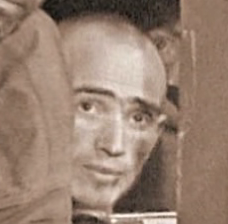
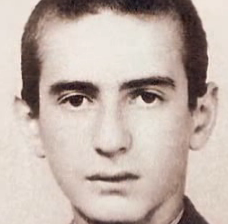 Not Wiesel at age 16 in 1945
Not Wiesel at age 16 in 1945
You can see for yourself from these two high-quality photographs supplied to me by a helpful reader that the face on the left is not Wiesel. A close inspection of the prisoners in the bunks in the famous photograph reveals that the eyebrows on many (including the one on the left above) were emphasized with a dark crayon/pencil … in other words, retouched or “photo-shopped.” On the right is what is claimed to be Elie Wiesel in 1944 at the age of 15.
The inmate on the left definitely has an aquiline nose and full, even sensual, lips. In this close-up, the receding hairline is visible on the recently shaved head. On the right, the real 15-year-old Elie Wiesel exhibits a normal youthful hairline, a bigger and longer nose and thinner lips. He also has a higher forehead and longer face than the more roundish-headed inmate. The eyes of the man on the left are not as deep-set under the eyebrows. His somewhat surprised, curious expression is not typical of Wiesel, whose expression was generally reserved, and often hooded.
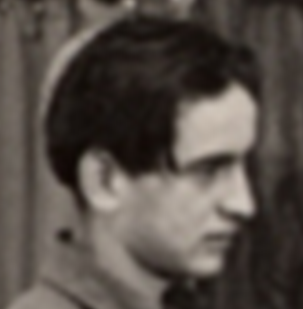
The close-up on the left appears to be the real Elie Wiesel in France later in 1945. He would be 17 or almost 17 years old in this picture. Notice the non-receding, youthful hairline with a very long front lock hanging to the side, and the straight nose .
This close-up image is from the photograph below, which is found at the USHMM Survivor Resource Center with the caption given below. (click here or on lower pic for an undistorted, larger image)
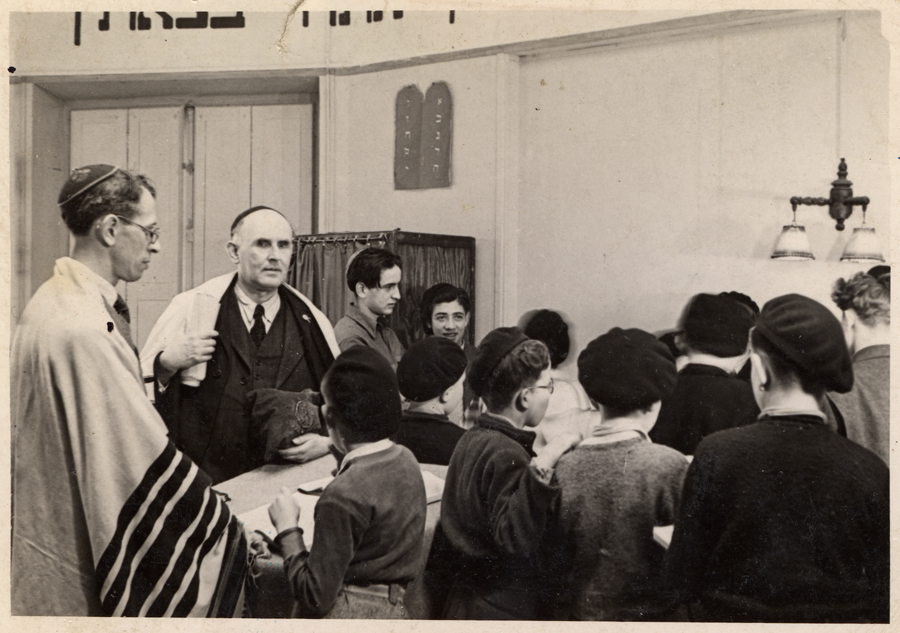
Above, Jewish boys gather for a prayer service in a chapel in an OSE children’s home in 1945. Those pictured include Elie Wiesel (seen in profile) and Jakob Rybsztajn standing next to him facing the camera. (I note that Elie Wiesel is older than the other boys in this picture, giving support to the idea that he acted in the role of counselor and sometime teacher to the newer, younger religious boys.)
Notice again the straight nose, the high forehead, deep-set eyes, large ears, sensitive mouth and slender neck. But also look at all that hair! The date of this picture is given by USHMM as 1945 and the location as Ambloy, [Loir et Cher] France. It says in the accompanying text “In October 1945 the children and staff of Ambloy were relocated to the Chateau de Vaucelles in Taverny (Val d’Oise).” That means this picture was taken between June and October 1945. They could have been celebrating Rosh Hashana, Yom Kippur or Sukkot.
But could his hair have grown to such a length from a shaved head in April 1945? No way, and thus we have another proof that the liberated Buchenwald inmate with the shaved head is NOT Elie Wiesel.
A PDF from my valued contributer examines the ages of the small group more closely. In my opinion, he has the ages of all four men a little too young but especially #2 and 4. Take a look: four men in bunk
Who first identified Elie Wiesel in the famous Buchenwald liberation photo?
In October 1983 the Jewish-owned New York Times published this photograph as part of an article in its high circulation Sunday NYT Magazine with the caption: “On April 11, 1945, American troops liberated the concentration camp’s survivors, including Elie, who later identified himself as the man circled in the photo.”
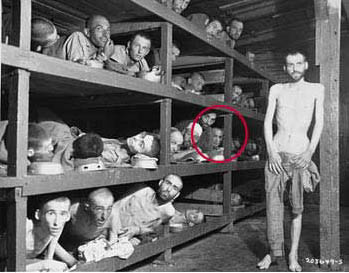
It was also in 1983 that Wiesel’s friend Sigmund Strochlitz began campaigning for a Nobel prize for Wiesel. Letters of nomination are due into the Nobel committee by Feb.1 of each year, so by January 1984, the committee was receiving letters nominating Wiesel from U.S. Senators such as Daniel Moynihan and Barry Goldwater (both Jewish). [see “How Elie Wiesel Got the Nobel Peace Prize“] The effort continued, with new and ever more innovative ideas, through 1985 and 1986 with the help of Jew John Silber, President of Boston University, Wiesel’s employer. Hundreds were enlisted into the effort.
The 1983 article in the New York Times that was the opening gun of the campaign was written by Jew Samuel Freedman and titled “Bearing Witness: The Life and Work of Elie Wiesel.” It included this line: “His name has been frequently mentioned as a possible recipient of a Nobel Prize, for either peace or literature.” Well, it had just begun to be mentioned … by this team of cheerleaders.
Wiesel pretends that he had nothing to do with it. In an interview in France in 2009, he said: “If you fight or if you do scientific research to get the Nobel, you never succeed and you should not succeed.” (Elie Wiesel, “messager de la memoire”) No, he did not fight but his mercenaries fought for him, and he used this photograph as his “research.” That this photograph played a large role is shown by the fact that immediately after the Nobel award ceremony in December 1986, Wiesel went to Yad Vashem Memorial in Jerusalem and posed in front of its prominent display there.
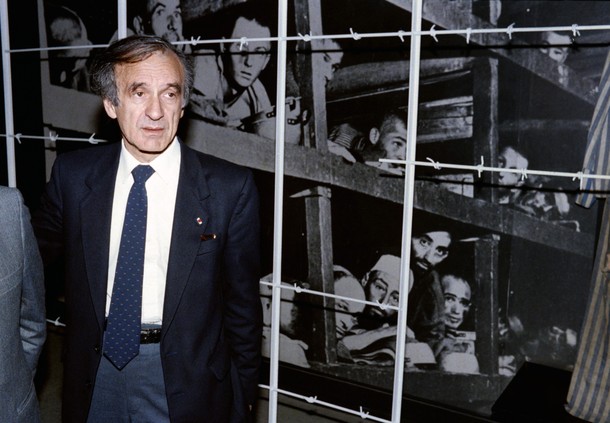
Elie Wiesel on Dec. 18, 1986 at Yad Vashem in Jerusalem
After the award was announced by the Nobel Committee, the New York Times published on Nov. 1 a severely cropped version of the Buchenwald photo (below) with the caption: “Elie Wiesel, the winner of the Nobel Peace Prize (at far right in the top bunk) in the Buchenwald concentration camp in April 1945, when the camp was liberated by American troops.” The picture accompanied an article by Jew Martin Susskind titled, “A Voice from Bonn: History Cannot Be Shrugged Off.”
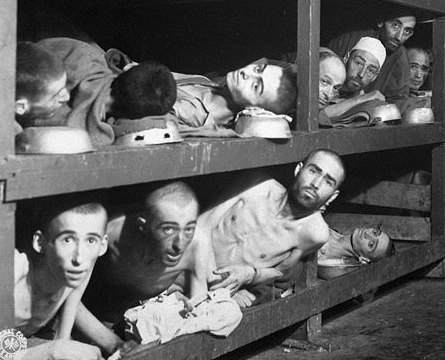
The role played by the tax-payer funded United States Holocaust Memorial Museum
Elie Wiesel finagled his way to becoming Founding Chairman of the United States Holocaust Memorial Council in 1980 after being chosen in 1978 by President Jimmy Carter as chairman of the President’s Commission on the Holocaust. Why the United States needed to do anything at all about the “Holocaust” is something only the 2.5% Jewish population in this country can answer. It is to satisfy them. Wiesel continued to chair the Council until 1986, when he reached his goal of becoming a Nobel Laureate. The USHMM was undoubtedly an important institutional heavyweight that leveraged him to the Nobel.
The USHMM naturally accepted that Wiesel was in the famous photograph as soon as he and the New York Times said he was. If you think the museum staff does real research, is searching for truth and/or is engaged in scholarship of any kind, you are badly mistaken. The museum represents official power only and is invested in keeping it in Jewish hands.
This photograph is the only document tying Elie Wiesel to the Holocaust
The only document that connects Elie Wiesel to the Auschwitz-Birkenau and Buchenwald experience he claims to have—in other words, his claim to be an authentic “Holocaust survivor”—is the famous Buchenwald liberation photograph. There are no records with his name and birth date for either camp. His books do not support his presence there very well. That’s why the Wiesel promoters, who wanted to anchor their man’s claim to be the unchallenged spokesman for the world’s greatest victims—which winning a Nobel prize would surely do—decided that they could pawn that unknown face off as the face of Wiesel. This decision was made in 1983. It’s certain that Elie Wiesel took part in making it, though the pretense is kept up by all that he was aloof from the entire process.
What you must do
When you comprehend the immense power that this simple photo comparison and commentary gives us, you know that we have it in our hands to break down the Wiesel legend if this knowledge is widely circulated. If you understand this, you know what you must do. You must post this article everywhere you can, you must tell everyone about it, send it to all you know … make sure that this photo comparison moves through the Internet and finds a home in as many places as possible. And keep it up, because once is not enough. I’ve done my part, readers. Now it’s up to you.
54 Comments
Category Featured | Tags: Tags: Ambloy France, Block 66, boys of Buchenwald, Buchenwald liberation, Elie Wiesel, Holocaust fraud, Ken Waltzer, Myklos Gruener, New York Times, Nobel Peace Prize, OSE, US Holocaust Memorial Museum, USHMM,
Social Networks: Facebook, Twitter, Google Bookmarks, del.icio.us, StumbleUpon, Digg, Reddit, Posterous.
Sunday, December 5th, 2010
By Carolyn Yeager
More reasons why I don’t believe Elie Wiesel is the author of Un di Velt Hot Gesvign
A dear reader has brought to my attention something that I covered in “The Shadowy Origins of Night, I, II and III”, but which deserves revisiting in order to shine a brighter light on some perhaps small, but meaningful, details that impact on the question of whether Elie Wiesel is the author of the Yiddish-language Un di Velt Hot Gesvign (And the World Remained Silent).
If we start with the map provided in “Shadowy Origins of Night, Part II,” we notice that Sighet is not in Transylvania, but in Maramures [sometimes called Marmaros], a district distinct from Transylvania. We see that Sighet is the only city shown in the eastern half of Maramures and is exactly on the border with Czechoslovakia.
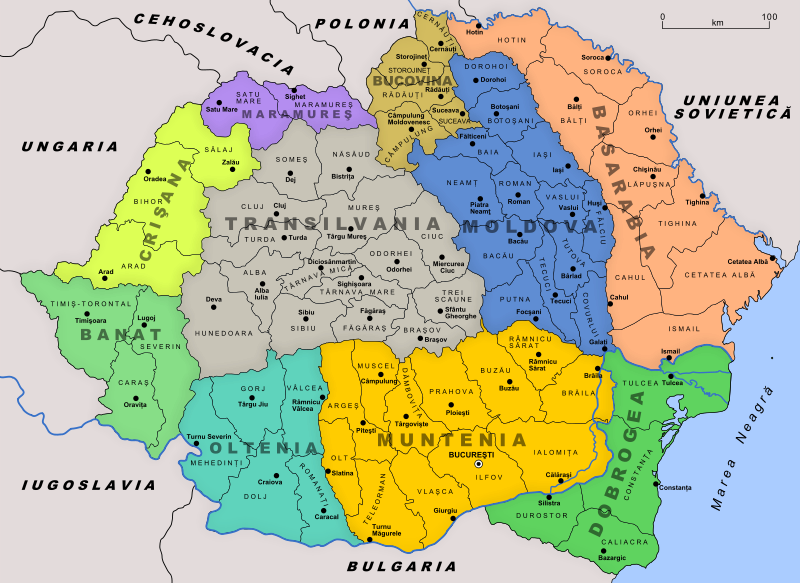
The writer of Un di Velt describes his hometown of Sighet on the first page of the book as
the most important city [shtot] and the one with the largest Jewish population in the province of Marmarosh. Until the First World War, Sighet belonged to Austro-Hungary. Then it became part of Romania. In 1940, Hungary acquired it again.” 1
It is totally reasonable for a man born in 1913, as was Lazar Wiesel, to write such a description since, at the time of his birth, Sighet was indeed part of the Austro-Hungarian Empire. After WWI [1919] it became part of Romania when the borders of Central and Eastern Europe were “rearranged” by the victorious powers [France, Britain, United States]. Then, in 1940, at his age of 27, it again changed rulers and borders, and became German-allied Hungary.
Lazar Wiesel lived through all these changes. He was old enough to understand them. As a man in his thirties at the end of the war, and his early forties when the book was published in 1955, Lazar Wiesel could be expected to write a comprehensive account of his experience—not only a good deal of historical/political material on his hometown and its townspeople, but covering his personal political/religious beliefs also. And this is indeed what we know is contained in the published book, Un di Velt. 2 Taking eight to nine years to complete the entire 862 pages of it, if that’s what it was, is quite reasonable, and even to be expected.
This makes a great deal more sense than Elie Wiesel’s incredible description of frantically typing 862 pages of “memory” during an ocean voyage to Brazil, without pre-planning, reference materials or access to other persons.
Returning to the location of Sighet, Wiesel, in the French and English versions La Nuit and Night, changed, on the first page, what had been described as the “most important city with the largest Jewish population in the Maramures province” to:
that little town in Transylvania where I spent my childhood.
Nothing more. Why does Elie Wiesel say that Sighet was in Transylvania? Could it be because the average person might recognize that name in association with Hungary and/or Romania, while they would not recognize Maramures or Marmarosh? And why would the author’s hometown go from the largest city in the entire province to a little town, presumably of no significance?
While it is true that more recently Maramureş, Romanian Crişana and the Romanian Banat are sometimes considered part of Transylvania, it is not precisely so. An inhabitant who identified with his region would probably not put it that way, but someone for whom the geography held no special place in his mind, heart or memory, this kind of generalization might be preferred. For example, if I don’t want a person[s] to know much about me or ask me questions, I will say I was born in the American mid-west and hope to leave it at that. If I don’t mind more being known, I’ll say exactly where, and give some detail. I know, because I do both and it’s very clear to me why.
Whatever the reasons Elie Wiesel had to cloud the picture of his hometown, it is clear that he and his publisher wanted to emphasize some things, de-emphasize, or delete, others, and shorten, shorten, shorten. This fictionalizes the account.
For me, the crux of whether to accept Elie Wiesel as the author of Un di Velt comes down to that odd paragraph in his 1995 memoir3 describing the burst of unbelievable energy that came over him while on a ship traveling between France and Brazil, when he typed 862 pages of 9 year-old memories on a portable Yiddish typewriter within no more than a two week time period.. Think back nine years in your own life and discover just how clearly you can remember everything that took place. Yes, his was an exceptionally traumatic time, but that doesn’t necessarily make one’s memories any clearer, just that certain parts stand out from the rest. Also, for me as a writer, just that high amount of sustained, concentrated typing would be an impossible task.
Another difficulty is that Wiesel didn’t describe the writing of his original manuscript until it appeared in his memoir, where, as I continue to remind, he gave it only one short paragraph! Or, if you will, a few sentences. I said above that it is a lot to swallow. I want to make it plain right now that I cannot, and thus do not, swallow it. I am convinced Elie Wiesel did not write Un di Velt Hot Gesvign [And the World Remained Silent]. I think it remains for him to prove that he did so, since his attempts at that so far only make us doubt it the more. He can begin by answering some of the many questions put to him on this website, as they are not frivolous or unfair.
In the remainder of this article, I will point to further items of interest and fact that, while not individually conclusive, bolster my position “not to believe.”
Night is a work of fiction
We must remember that Night was classified as fiction when it was first published. Today, there is a good deal of embarrassed uncertainty as to how to categorize it. The original English-language Hill and Wang publication in 1960 listed the book as Judaica/Literature. The new translation from the same publisher issued in 2006 says it is Autobiography/Jewish Interest. On the Wikipedia page for Night,4 it is called “Autobiography, memoir, novel”—all three. Words lose their meaning when dealing with Elie Wiesel, and we’re familiar with his professed difficulty with “the limitations of language.”
On that same Wikipedia page, we read:
[I]t remains unclear how much of Wiesel’s story is memoir. He has reacted angrily to the idea that any of it is fiction, calling it his deposition, but scholars have nevertheless had difficulty approaching it as an unvarnished account.
Most who write about Wiesel are not scholars or, if they claim to be, they don’t live up to the title. Ruth Franklin, though an avid apologist for Wiesel, admits that the original Yiddish author blames the Jewish concept of “chosenness” as the source of the Jews’ troubles, and she accepts that Wiesel is the author.5 Yet this is an idea that Wiesel would never entertain for an instant. Franklin writes:
The Yiddish version was an historical work, political and angry, blaming the Jewish concept of chosenness as the source of the Jews’ troubles. Wiesel wrote in the 1956 Yiddish version: “In the beginning was belief, foolish belief, and faith, empty faith, and illusion, the terrible illusion. … We believed in God, had faith in man, and lived with the illusion that in each one of us is a sacred spark from the fire of the shekinah, that each one carried in his eyes and in his soul the sign of God. This was the source—if not the cause—of all our misfortune.
Naomi Seidman, professor of Jewish culture at the Graduate Theological Union, whose article 6 I have referred to above and quoted in “Shadowy Origins,” documented the transition from a historical account of events to an autobiographical novel, concluding that Night transforms the Holocaust into a religious event, the abdication of God, with the witness [Eliezer] both priest and prophet. Wiesel himself has said that Auschwitz is as important as Mount Sinai—where in the Bible the Ten Commandments were given to Moses by God.7
On the Internet, we find various sites that still call Night a novel. At the website About.com: Secondary Education, Night is called “A novel by Elie Wiesel.”
At the website Yahoo!Answers, the question is asked: Discuss the significance of “night” in the novel Night by Elie Wiesel?
In 2006, Alexander Cockburn wrote 8:
Amazon.com […] had been categorizing the new edition of Night under “fiction and literature” but, under the categorical imperative of Kakutani’s “memory as a sacred act”9 or a phone call from Wiesel’s publisher, hastily switched it to “biography and memoir”. Within hours it had reached number 3 on Amazon’s bestseller list. That same evening, January 17, Night topped both the “biography” and “fiction” bestseller lists on BarnesandNoble.com.
In the same article, Cockburn tells of an interview with Eli Pfefferkorn of Toronto, who related this story:
“In 1981, Wiesel invited me to give a talk to his seminar students at Boston University. In the course of my talk, I discussed the relationship between memory and imagination in a number of literary works. I then pointed out the literary devices he used in Night, devices, I stressed, that make the memoir a compelling read. Wiesel’s reaction to my comments was swift as lightning. I had never seen him as angry before or since. In the presence of John Silber, the then President of Boston University, and my own Brown University students whom I invited, he lost his composure, lashing out at me for daring to question the literalness of the memoir. In Wiesel’s eyes, as in the eyes of his disciples, Night assumed a level of sacrosanctity, next in importance to the giving of the Torah at Mt. Sinai. In terms of veracity, it is a factually recorded work, virtually meeting Leopold von Ranke’s benchmark of historical accounts: Wie es eigentlich gewessen, how it really was.
Examples of fiction in Night
Beyond all the well-known fictions in Night, there are some that may have gone largely unnoticed. For example, another dear reader pointed out that on page 68 of the 1960 edition,10 a hanging is described as taking place at Buna [Monowitz].
The head of the camp began to read his verdict, hammering out each phrase:
“In the name of Himmler … prisoner Number … stole
[…]
prisoner Number …is condemned to death.”
The reader commented, “The person who wrote that could never have been around any SS officers. Heinrich Himmler was only referred to as Reichsfüher.” He further points to the fact that in the new 2006 translation of the book, the passage was changed [on page 62] to:
In the name of Reichsführer Himmler …
Someone obviously pointed out the error to Wiesel or his editors. But this doesn’t fix it either, because not even a lowly camp inmate would be sentenced to death in the name of the second in command. The order would have to read: In the name of the Führer …
Says my reader: This is enough in itself to prove that Wiesel had never been around any SS personnel.
There is another similar incident in Night that is widely considered to be fiction, in full or in part. This is the 3-person hanging scene, also known as the “Crucifixion” scene. It appears on page 70 in the 1960 edition:
One day when we came back from work, we saw three gallows rearing up in the assembly place, three black crows. Roll call. SS all round us, machine guns trained: the traditional ceremony. Three victims in chains—and one of them, the little servant, the sad-eyed angel.
The SS seemed more preoccupied, more disturbed than usual. To hang a young boy in front of thousands of spectators was no light matter. The head of the camp read the verdict. All eyes were on the child. He was lividly pale, almost calm, biting his lips. The gallows threw its shadow over him.
This time the Lagerkapo refused to act as executioner. Three SS replaced him.
The three victims mounted together onto the chairs.
The three necks were placed at the same moment with the nooses.
“Long live liberty!” cried the two adults.
But the child was silent.
“Where is God? Where is He?” someone behind me asked.
At a sign from the head of the camp, the three chairs tipped over.
Total silence throughout the camp. On the horizon, the sun was setting.
“Bare your heads!” yelled the head of the camp. His voice was raucous. We were weeping.
“Cover your heads!”
Then the march past began. The two adults were no longer alive. Their tongues hung swollen, blue-tinged. But the third rope was still moving; being so light, the child was still alive …
For more than half an hour he stayed there, struggling between life and death, dying in slow agony under our eyes. And we had to look him full in the face. He was still alive when I passed in front of him. His tongue was still red, his eyes were not yet glazed.
Behind me, I heard the same man asking:
“Where is God now?”
And I heard a voice within me answer him:
“Where is He? Here He is—He is hanging here on this gallows …”
Except that there was no child. And probably no crucifixion-style hanging at all.
Alexander Cockburn writes in the article referenced above that after hearing several Jews express doubt about the story, he called Raul Hilberg, author of a standard work on the Holocaust, who was at that time 80, at Hilberg’s home in Vermont. [I have added the underlining]
“From a purely academic viewpoint”, Hilberg began, “it would be interesting to have a scholarly edition, comparing the Yiddish version with subsequent translations and editions, with appropriate footnotes, Wiesel’s comments etc. He was addressing two entirely different audiences, the first being the Yiddish-speaking Jews, members of the world of his youth whom he addressed in nineteenth-century terms. There’s more detail, more comment. I made that suggestion to Wiesel and he didn’t react favorably.”
Hilberg turned to the crucial scene: “I have a version of the hanging from an old survivor with the names of all three adults.” That survivor had said that there was no boy among the three. Hilberg mentioned this in a review of Night, in which, he told me, “I made no secret of our differences. But whereas it [the age of the central figure in the hanging] may seem somewhat small, it makes a very big difference to Christians, particularly Catholics, because it’s very clear that mystics are intensely interested in the scene because it seems to replicate the crucifixion. It made a considerable impact. So the fact that this figure may not have been a boy at all is disturbing.”
“It would appear”, Hilberg went on, “from the record I have, that some witnesses have questioned whether this scene took place at all. I have a long statement by an older man, a man whom I judge to be quite trustworthy, though one must always remember that things are sometimes observed or heard about later. I talked recently to a survivor of that section of the camp who said it [the hanging of the three] didn’t take place, but maybe it took place earlier. I don’t know. Dating these things is hard for survivors. Some have doubted this would have taken place. Buna was a work camp, so this other survivor, a PhD in history and a very intelligent man, didn’t believe it. I said to him, ‘How do you know this didn’t happen?’ I consider it not only a possibility but plausible. But age is a big issue to some people. That’s something [Wiesel] did not discuss in the new edition of the book.” 11
Arthur Butz reminds us12 that Bruno Dössekker, who never came near a German concentration camp in wartime, published an acclaimed purported memoir of the ordeals of a certain Jew, Binjamin Wilkomirski, at Majdanek, Auschwitz, and other camps. When he was exposed as a fraud, many important supporters remained loyal to him, on the grounds, roughly speaking, that his account sounded powerful.
Age Confusion
Continuing on with the issue of age and the part it plays in Elie Wiesel’s credibility as a holocaust survivior—so very related to his credibility as the author of Un di Velt—we go to page 39 in the original 1960 edition of Night. Eliezer and his father have just arrived at Birkenau and been separated from the women and children into the men-only group. A prisoner speaks to him.
“Here, kid, how old are you?”
It was one of the prisoners who asked me this. I could not see his face, but his voice was tense and weary.
“I’m not quite fifteen yet.”
“No. Eighteen.”
“But I’m not,” I said. “Fifteen.”
“Fool, Listen to what I say.”
Then he questioned my father, who replied:
“Fifty.”
The other grew more furious than ever.
“No, not fifty. Forty. Do you understand? Eighteen and forty.”
He disappeared into the night shadows.
In May 1944, Elie Wiesel, born Sept. 30, 1928, was 15 years old; his 16th birthday was still four months away. So what does it mean for the star “witness” of the story, Eliezer, to say he is 14, going on 15? If this is Wiesel’s “deposition”, why would he make himself months younger than he really was? Does he want to emphasize his tenderness and vulnerability? Or was he simply careless, forgetting what his age would have been and what season of the year it was?
Once again, the error was corrected in the 2006 new translation—there he answers that he’s fifteen, not “going on fifteen.” The prisoner tells him to say he’s eighteen.
On page 41:
We continued our march toward the square. In the middle stood the notorious Dr. Mengele […]
I was already in front of him:
“How old are you? He asked, in an attempt at a paternal tone of voice.
“Eighteen.” My voice was shaking.
“Are you in good health?”
“Yes.”
“What is your occupation?”
Should I say that I was a student?
“Farmer,” I heard myself say.
Apparently, this means that Eliezer and his father are accepted to be 18 and 40 years of age. Eliezer is adding three years to his stated age of 15. This forces us to ask once again those never-satisfactorily answered questions: Were the Germans so easily fooled or were they not? Did they or did they not keep careful records? Did they follow their policies to the letter or were they sloppy at times? It seems to depend on what’s most convenient for the camp survivor’s story—on one occasion they lie about their age and get away with it; on another, the SS keep impeccable records and know everything.
According to holocaust historiography, if, upon arrival at Birkenau, you were too young or too old to work [or were a woman with young children], you were sent immediately to the gas chamber. [Although in Night no such name is used; it is always called the crematoria.] Thus, we are to believe that Eliezer and his father were saved from that fate by lying about their ages.
The problem with this explanation comes later at Buchenwald, when Eliezer’s father dies shortly after arrival, on January 29, 1945. On page 114, Elie Wiesel writes:
I had to stay at Buchenwald until April eleventh. I have nothing to say of my life during this period. It no longer mattered. After my father’s death, nothing could touch me any more.
I was transferred to the children’s block, where there were six hundred of us.
If Wiesel had been entered into Birkenau as an 18-year-old, he would now be listed as 19—not a child. Why would he have been assigned to the children’s block after the death of his father? It’s true it was later called the orphan’s block by some, but that term may have come about later when the underage inmates who could not be reunited with a family member were sent to an orphanage in France.
We have no records for the death of Shlomo Wiesel at Buchenwald nor a registration [entry] number for either Shlomo or Eliezer Wiesel. But whatever the facts are finally determined to be, according to Elie Wiesel’s later writing he was there and was once again sixteen years old. And, in fact, the birth date on the transport list to France for the person of the mysterious Lázár Wiesel was 1928.
Wiesel describes his own book
Wiesel has said of Night:
…my first narrative was an autobiographical story, a kind of testimony of one witness speaking of his own life, his own death. All kinds of options were available: suicide, madness, killing, political action, hate, friendship. I note all of these options: faith, rejection of faith, blasphemy, atheism, denial, rejection of man, despair and in each book I explore one aspect. In Dawn I explore the political action; in The Accident, suicide; in The Town Beyond the Wall, madness; in The Gates of the Forest, faith and friendship; in A Beggar in Jerusalem, history, the return. All the stories are one story except that I build them in concentric circles. The center is the same and is in Night.13
“Night was the foundation; all the rest is commentary. In each book, I take one character out of Night and give him a refuge, a book, a tale, a name, a destiny of his own. 14
First, he calls his book an autobiographical story, a kind of testimony. These are modifiers indicating it is not a true autobiography, or a true testimony. Then, he saw options in it for further exploitation. From this story—Un di Velt Hot Gesvign as the original treasure-trove?—he can get a whole career-ful of books. Wiesel has authored nearly 40 books, all given credence and believability because of this one Yiddish original.
He also calls it “one witness speaking of his own life, his own death.” Of course, Eliezer didn‘t die, but Wiesel is referring to his spiritual death after undergoing the horrors of the holocaust, as he describes it. However, and this is very important, the author of Un di Velt was not a “corpse” looking back at himself in the mirror at the end of the book, but a revitalized man [not a child] looking forward to his regained health, his freedom, and the opportunity to give his account of it in his own way.
This is a huge point that all pro-Wiesel “scholars” downplay or completely ignore. Only Naomi Siedman addresses the questions it raises, but then she also lets it lay. Another opportunity for scholars that is not taken advantage of is Wiesel’s insistence that the “Holocaust” is the private domain of the “survivors.” Typical of his statements is this one:
The Holocaust cannot be described, it cannot be communicated, it is unexplainable. To me it is a mystical event. I have the feeling almost of sin when I speak about it.15
This rings false coming from someone who has made a 50-year career and gotten rich out of writing and speaking about “The Holocaust.” If it “cannot be described,” this releases him from accurate description and covers for the sense we all get that he is not speaking from first-hand experience. If it is “unexplainable,” that can explain his contradictory and foolish statements. Elie Wiesel hides dishonesty in mysticism, which is what Alfred Kazin meant when he criticized Wiesel publicly by calling him “a mystifier.”16
And isn’t it a strange choice of words for Wiesel to confess to a “feeling of sin” when he speaks about the holocaust. It’s a psychological truism that we’ve learned watching TV crime shows, if nowhere else, that the criminal has an urge to confess and therefore will often admit the truth without admitting it. [Larry Silverstein of 9/11 fame confessing to the “pulling” of Bldg. 7 comes to mind.]
To another writer,17 Wiesel said:
I knew the role of the survivor was to testify. Only I did not know how. I lacked experience, I lacked a framework. I mistrusted the tools, the procedures. Should one say it all or hold it all back? Should one shout or whisper? Place the emphasis on those who were gone or on their heirs? How does one describe the indescribable? How does one use restraint in re-creating the fall of mankind and the eclipse of the gods? And then, how can one be sure that the words, once uttered, will not betray, distort the message they bear? [my added underlining]
This passage now reverberates very strongly to me that Wiesel is confessing his uncertainty as to how to construct a holocaust survivor story that will be convincing. He lacks experience—not in writing, but as a camp inmate. He lacks a framework—that would be the personal experience that he doesn’t have. He doesn’t know how to tell it, not because he lacks writing expertise, but because he lacks first-hand knowledge.
He doesn’t want to do it wrong and be found out to be someone who wasn’t there … a fraud! Later, he decided to describe it as indescribable. Not having suffered all that much, he decided to project overwhelming suffering for every inmate. The very fact that he calls it “the fall of mankind and the eclipse of the gods” tells us—screams at us—if only we will listen, that what he describes doesn’t exist in our real world. Wiesel continues with this:
So heavy was my anguish that I made a vow: not to speak, not to touch upon the essential for at least ten years. Long enough to see clearly. Long enough to learn to listen to the voices crying inside my own. Long enough to regain possession of my memory. Long enough to unite the language of man with the silence of the dead 18
This, of course, doesn’t make sense; it’s nonsense talk. Wiesel decided to wait until he could learn more about it, read what others wrote, talk to survivors. Then, lo and behold, he found a manuscript that he could claim to be his very own, and his real career was launched.
Endnotes:
- Un di Velt Hot Geshvign, Eliezer Wiesel, page 7, translated by Naomi Siedman in “Elie Wiesel and the Scandal of Jewish Rage.”
- “Elie Wiesel and the Scandal of Jewish Rage,” Naomi Siedman, Jewish Social Studies, Dec. 1996.
- Elie Wiesel, All Rivers Run to the Sea, Knopf, New York, 1995.
- http://en.wikipedia.org/wiki/Night_(book)
- “A Thousand Darknesses”, Ruth Franklin, The New Republic, March 23, 2006.
- Siedman, ibid.
- http://en.wikipedia.org/wiki/Night_(book)#Memoir_or_novel
- “Truth and Fiction in Elie Wiesel’s Night: Is Frey or Wiesel the Bigger Moral Poseur,” Alexander Cockburn, CounterPunch.com, April, 2006. Found online at http://www.rense.com/general70/elie.htm
- In the New York Times for January 17 [2006], Michiko Kakutani wrote in her usual plodding prose, with her usual aversion to any unconventional thought, that “Mr. Frey’s embellishments of the truth, his cavalier assertion that the ‘writer of a memoir is retailing a subjective story,’ his casual attitude about how people remember the past — all stand in shocking contrast to the apprehension of memory as a sacred act that is embodied in Oprah Winfrey’s new selection for her book club, announced yesterday: Night, Elie Wiesel’s devastating 1960 account of his experiences in Auschwitz and Buchenwald.” From Cockburn, see footnote 8.
- Elie Wiesel, Night, Hill and Wang, New York, 1960.
- Cockburn, ibid.
- “Historical Past vs. Political Present,” Journal of Historical Review, vol 19, Nov/Dec 2000. Online at http://www.ihr.org/jhr/v19/v19n6p12_Butz.html
- Harry James Cargas, In Conversation with Elie Wiesel, Paulist Press: New York, 1976, p. 86
- Cargas, ibid, p. 3
- ”Elie Wiesel: Out of the Night,” Morton A. Reichek, Present Tense. Spring 1976, p, 42
- Cockburn, ibid.
- Wiesel, “An Interview Unlike Any Other,” in A Jew Today, trans. Marion Wiesel (New York, 1979), p.15.
- “Interview,” ibid.
11 Comments
Category Featured | Tags: Tags: Alexander Cockburn, Buchenwald liberation, Naomi Siedman, Night, Romania, Ruth Franklin, Sighet, Un di Velt Hot Gesvign,
Social Networks: Facebook, Twitter, Google Bookmarks, del.icio.us, StumbleUpon, Digg, Reddit, Posterous.
Wednesday, September 22nd, 2010
By Carolyn Yeager
copyright 2010 Carolyn Yeager
Elie Wiesel has been identified – in some cases has identified himself – in these three photographs. A close examination brings up many questions.
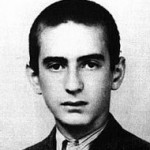
#1 – Elie in 1944, age 15 |
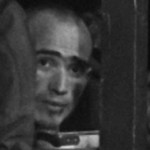
#2 – Elie on April 16, 1945, age 16½ |
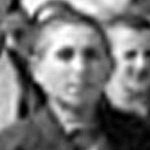
#3 – Elie on April 27, 1945, age 16½ |
Do any two of these pictures look like the same person? You might think that picture #2 or 3 has a vague resemblance to picture #1, but pictures 2 and 3 don’t in the least resemble each other. The man in picture #2 has a sharp aquiline nose, high cheekbones, full lips and looks quite a bit older than 16 years of age, while the round-headed lad in picture #3 has a wide face, short nose and low forehead. He looks younger than 16.
Picture #2 can be recognized as a close-up from the Famous Buchenwald Liberation Photo. [see page under The Evidence]. Weasel has maintained since the 1980’s that this is his face.
Picture #3 is taken from the photograph below. He is the boy in front of the tall boy in the left column of boys leaving Buchenwald, fourth from the front (the third boy in line is hidden from view). He’s been identified as Elie Wiesel by Prof. Kenneth Waltzer on his Michigan State University website. Wiesel has not denied it. The U.S. Holocaust Memorial Museum, however, doesn’t claim that Elie is in this picture (see USHMM below).
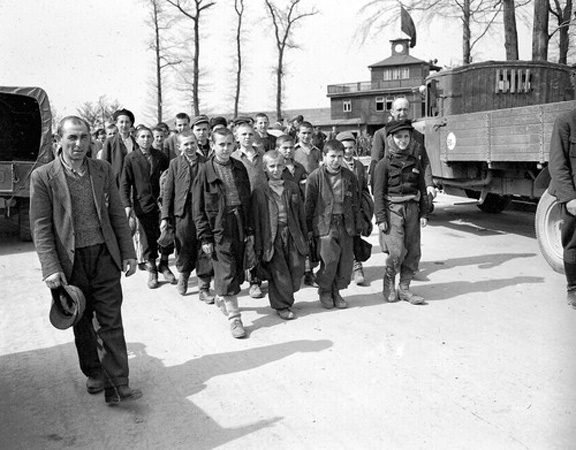
Above: Children march out of Buchenwald to a nearby American field hospital where they will receive medical care. Buchenwald, Germany, April 27, 1945. — Wide World Photo [Photo and caption from USHMM website]
Below: From Ken Waltzer’s MSU Newsroom Special Report page
Elie Wiesel at Buchenwald
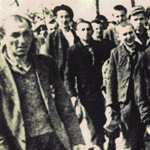
Elie Wiesel is fourth on the left, in front of the tall youth with beret.
Picture courtesy of the late Jack (Yakov) Werber, Great Neck, New York.
Waltzer writes on this same page:
In “Night,” Wiesel says that when he viewed himself in a mirror after liberation, he saw a corpse gazing back at him. But another picture [the one above] taken after liberation on April 17 [he has the date wrong], when the boys were led to the former SS barracks outside the camp, shows Wiesel marching out, fourth on the left, among a phalanx of youth moving together, heads held high, a group together guided by prisoners who had helped save them.
According to Waltzer, Elie Wiesel had a fast recovery to health, body mass and optimism, which Elie himself has never claimed. According to Buchenwald documents, these youths were not sent to France until July 16, 1945 (Fig. 12.4, 12.5),
Waltzer teaches German history and directs the Jewish Studies Program at MSU which includes courses on the Holocaust. He is writing a book about the orphan boys at Buchenwald titled “The Rescue of Children at Buchenwald.” Will Prof. Waltzer offer an explanation in his book for Elie Wiesel’s fit appearance in this photograph? He also accepts the man in the barracks photo as 16-year-old Wiesel. But then he has to, doesn’t he. How will he reconcile these two faces only eleven days apart?
USHMM
The USHMM features the picture shown below on its website—which Waltzer also refers to—and tells us that Elie Wiesel is among these boys without pointing out which one he is. Failing to find anyone who resembles Elie, I wrote to the USHMM asking them to identify him, but received no reply. [Update – because of a reader and also other pictures of Wiesel in France that surfaced later, I now believe Wiesel could be the darkish face in the 2nd to the last row, looking over the shoulder of the boy in a military-looking jacket and to the left of two boys in light-colored caps or berets. ]
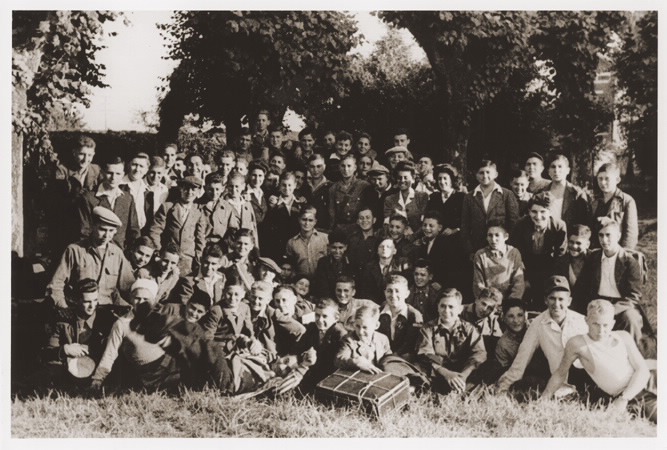 Group portrait of Jewish displaced youth at the OSE (Oeuvre de Secours aux Enfants) home for Orthodox Jewish children in Ambloy. Elie Wiesel is among those pictured. Ambloy, France, 1945. — USHMM, courtesy of Willy Fogel
Group portrait of Jewish displaced youth at the OSE (Oeuvre de Secours aux Enfants) home for Orthodox Jewish children in Ambloy. Elie Wiesel is among those pictured. Ambloy, France, 1945. — USHMM, courtesy of Willy Fogel
The U.S. Holocaust Museum dates this picture simply as 1945. It is definitely summer; the boys are dressed in their suits and “traveling clothes,” as if they had just arrived. A large suitcase is being held by a young boy seated in the front row. It fits in every respect the records for the Buchenwald transport that left Germany for France on July 16, 1945.
Wiesel is careful not to give dates for many important events in his memoir All Rivers Run to the Sea. In this book he writes in detail about his trip to France and his early years with the Oeuvre de Secours. Yet he gives not a single date, until he mentions that he first met his future mentor, Shushani, sometime in 1947.1 He writes of being active with the other Jewish youths – engaged in classes, choir practice, trips and flirtations – but strangely not a single photograph is available.
The next picture of Elie Wiesel I have found was taken in 1949. In fact, it is the first picture of him we can be sure of since the 15-year-old portrait of 1944, prior to deportation (picture #1). Why are there no pictures of Wiesel during all the years he was in the Jewish welfare system in France? We are told his sister Hilda, living in Paris, recognized him in 1945 in a photograph of OSE orphans that was published in a newspaper or magazine. What picture was that? [This question was finally answered. See http://www.eliewieseltattoo.com/another-photo-of-young-elie-wiesel-that-is-not-elie-wiesel/ The group photo above? There are no easy or available answers to these questions. It doesn’t take much imagination, however, to consider that it’s because there aren’t any that “fit” the story.
I find it more than ironic that on the page “Elie Wiesel Timeline and World Events, 1928-1951” there are three photographs and Elie Wiesel is not in any one of them!
The next picture I can find of Elie Wiesel was taken in 1949, on a ship heading for Israel. We see here the real Elie – long, narrow face, long nose (but not aquiline as in picture #2 above), large ears, high broad forehead, a slender build. He is 20 years old and a journalist, and has probably never looked better. [Maybe that’s why the picture was released.] We learn in his memoir that on May 14, 1948, when David Ben Gurion read out the Israel Declaration of Independence, Elie Wiesel had been working already for around six months for the Irgun Yiddish weekly newspaper Zion in Kamf (Zion in Struggle)– yes, Irgun, the terrorist gang. He remained with the Irgun until they closed their European offices in January 1949. He was then persuaded to go where the action was—to Israel. Helped by the Jewish Agency, and traveling with a few Irgun veterans, he boarded the ship Negba in May or June (uncertain), crossing to Haifa, Israel.2 This picture must have been taken during that trip.
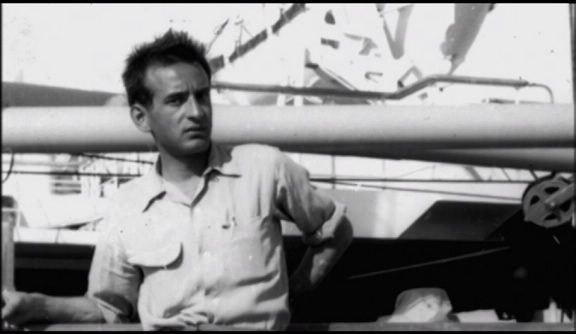 Elie Wiesel on a boat to Israel in 1949
Elie Wiesel on a boat to Israel in 1949
These are the faces of young Elie Wiesel during his “years of travail” that we have at our disposal—not much. I offer the opinion that too much is missing to accept unquestionably the story of his life, during these years 1944-1950, that has been manufactured for public consumption. Only two pictures: before Auschwitz and after his connection with the orphanage was concluded, are definitely him. The search continues.
Endnotes:
- Elie Wiesel, All Rivers Run to the Sea, Alfred Knopf, 1995, p 121.
- ibid, pg. 174-180
14 Comments
Category Featured | Tags: Tags: Buchenwald liberation, Irgun, Ken Waltzer, Oeuvre de Secours, Shushani/Chouchani, USHMM,
Social Networks: Facebook, Twitter, Google Bookmarks, del.icio.us, StumbleUpon, Digg, Reddit, Posterous.
Saturday, September 11th, 2010
by Carolyn Yeager
copyright 2010 carolyn yeager
What can be simpler than to compare two signatures of the same name to determine whether they are indeed the same or two different individuals? Fortunately, we have available not only the signature of Elie Wiesel, but also that of Lázár Wiesel. The latter is on the “Military Government of Germany Concentration Camp Inmates Questionnaire.” This Questionnaire (Fragebogen in German) can be seen among The Documents pertaining to the Lazar Wiesel/Elie Wiesel question.
The importance of this lies in the fact that we only have one Lazar Wiesel at a time at Buchenwald, according to the records. Lazar Wiesel, born Sept. 4, 1913 arrived at the camp on January 26, 1945, along with his brother Abram, born Oct. 10, 1900, in a large transport from Auschwitz. They both have Buchenwald registration (or entry) numbers.
After the liberation in April, a questionnaire is filled out by a Lázár Wiesel who accents his name in the Hungarian style, giving a birth date of Oct. 4, 1928, and this Lazar is listed on the “childrens” transport to France in July. Neither of these Lazar Wiesel’s fit Elie Wiesel with his birth date of Sept. 30, 1928, and now I find his signature doesn’t match either.
On the left, Elie Wiesel’s well-known signature; on the right, the signature of Lázár Wiesel (last name is written first).

 Two more examples of Elie’s book signing. The same style of open, very loose script is also found on the form he filled out for the Yad Vashem Central Database of Shoah Victims, testifying to his father Shlomo’s death at Buchenwald in January 1945. You can view it on their Internet site. Shlomo Vizel is on page 4 of the names.
Two more examples of Elie’s book signing. The same style of open, very loose script is also found on the form he filled out for the Yad Vashem Central Database of Shoah Victims, testifying to his father Shlomo’s death at Buchenwald in January 1945. You can view it on their Internet site. Shlomo Vizel is on page 4 of the names.
I suggest that this signature comparison leaves little doubt that the two men are not the same person. Elie Wiesel is NOT the Lázár Wiesel who was liberated from Buchenwald, or who traveled to France with the “Buchenwald Orphans.”1 The young Lázár Wiesel, born Oct. 4, 1928 according to these Buchenwald documents, and whose name and birth date appear on the transport list of “orphaned children” sent from Germany to France in July 1945 (see #14 on The Documents page) has such a visibly different style of writing from the Elie Wiesel who falsely claims to be on that list,2 that the two cannot be confused.
DATES OF ARREST DON’T MATCH
There is more evidence that they are not the same person in the form of the date of arrest shown on the same questionnaire. The date of arrest of Lázár Wiesel is given as April 16, 1944. That is the same day Samuel Jakobovits was arrested. Samuel and Lázár gave each others name as one of three references on their questionnaires, suggesting they were probably friends, or at least acquaintances, that had arrived at the same time.
Myklos Grüner’s date of arrest on his questionnaire is also 16 April 1944, from the city or surrounding area of Nyiregyhaza, Hungary. This can raise a question about the use of April 16 as some kind of “standard” date used by the military authorities in charge of the questionnaires. However, in his book Stolen Identity, Grüner does specify that on April 14, Hungarian gendarmes evacuated the entire population in the ghettos around the city of Nyiregyhaza, approximately 17,000 people. Six days later, “we too were driven from our homes” in Nyiregyhaza to a “holding area” leading to a railway track with a large loading platform, whereupon they boarded a “goods train.” Their destination was Auschwitz-Birkenau, where they would have arrived sometime between April 24 and April 30, 1944 (depending upon how long they stayed in the “holding area” before starting the 3 to 4-day journey).3
By contrast, we know by the authority of Elie Wiesel’s book Night that his family was not arrested on that date. In the “revised and updated” new translation of 2006, Wiesel gives his family’s date of deportation to the “small ghetto” as May 17, 1944. I arrive at this date because Wiesel writes that it was “some two weeks before Shavuot” (Shavuot fell on May 28 in 1944 4) that the deportation order was announced to his family and neighbors. [Remember, Sighet had 90,000 residents, at least one-third of them Jews, while Wiesel makes it sound like he lived in a little village.] Departures were to take place “street by street” starting the next day. That would be May 15. But the Wiesel family was scheduled to leave in the 3rd group, which left two days later, on May 17. After being marched to the “small ghetto,” they stayed there “a few days.” On a “Saturday,” they boarded trains.5 The 20th of May, 1944 was a Saturday
Thus, according to official concentration camp documents and Elie Wiesel’s own testimony, we can demonstrate that Lázár Wiesel was arrested approximately one full month prior to Elie Wiesel being arrested. Elie Wiesel is not the Lázár Wiesel of the Buchenwald documents.
Footnotes:
- Ken Waltzer will present on his book-in-progress, The Rescue of Children and Youth in Buchenwald, at James Madison College on April 11, 2007. In this book, Waltzer explores why, when the U.S. Third Army liberated Buchenwald, April 11, 1945, there were 904 children and youth still alive to be liberated. Among these were Elie Wiesel, a 16-year-old youth from Transylvania, (later Nobel Peace Prize winner) and also Israel Meir Lau, an 8-year-old child from Poland (later Israel Prize winner. http://www.jmc.msu.edu/faculty/show.asp?id=32
- It may be that Elie Wiesel has not made such claims himself, but they have been made by others to support the thesis that he is the one referred to. These others include Ken Waltzer, director of the Jewish Studies Program at Michigan State University, and the U.S. Holocaust Memorial Museum.
- Nikolaus Grüner, Stolen Identity, Stockholm, 2005-2006, pg. 18-19
- “On the second day of Shavuot, 1944 (29 May 1944)” http://www.shtetlinks.jewishgen.org/Vamospercs/
- Elie Wiesel, Night, Hill & Wang, New York, 2006, pg.12-21.
14 Comments
Category Featured | Tags: Tags: Buchenwald liberation, Miklos Grüner, military govt. questionaires, Night, Wiesel signatures,
Social Networks: Facebook, Twitter, Google Bookmarks, del.icio.us, StumbleUpon, Digg, Reddit, Posterous.
Sunday, September 5th, 2010
by Carolyn Yeager
copyright 2010 Carolyn Yeager
Part III: Nine reasons why Elie Wiesel cannot be the author of Un di Velt Hot Gesvign (And the World Remained Silent).
1. The only original source for the existence of an 862-page Yiddish manuscript is Elie Wiesel.
Wiesel’s 1995 memoir All Rivers Run to the Sea is the first time he mentions writing this book in the spring of 1954 on an ocean vessel on his way to Brazil.
In the original English translation of Night, Hill and Wang, 1960, there is no mention of the Yiddish book from whence it came. Nowhere does it name the original version and publication date. There is no preface from the author, only a Foreword by Francois Mauriac who was satisfied to simply call the book a “personal record.”
In his 1979 essay titled “An Interview Unlike Any Other,” Wiesel declares that his first book was written “at the insistence of the French Catholic writer Francois Mauriac” after their first meeting in May 1955. There is no mention in this essay of a Yiddish book, of any length. By “his first book” he obviously meant La Nuit, published in 1958 in France. 38
In his Nobel Peace Prize acceptance speech in Dec. 1986, Wiesel doesn’t mention his books, but refers twice to the “Kingdom of Night” that he lived through and once says, “the world did know and remained silent.” So it’s not like he was unaware of this book title. 39
Thus, All Rivers Run appears to be the first mention of the Yiddish origin of Night. Why did Elie Wiesel decide to finally write about And the World Remained Silent in that 1995 memoir? Could it have been because in 1986, after being formally awarded the Nobel Peace Prize in Stockholm, he was “reunited” with a fellow concentration camp inmate Myklos Grüner, who, after that meeting, read the book Night that Wiesel had given him, recognized the identity of his camp friend Lazar Wiesel in it, and from that moment began his investigation of who this man named Elie Wiesel really was?
Grüner writes in his book Stolen Identity, “My work of research to find Lazar Wiesel born on the 4th of September 1913 started first in 1987, to establish contact with the Archives of Buchenwald.” 40 He was also writing to politicians and newspapers in Sweden. This could not have failed to attract the notice of Elie Wiesel and his well-developed public relations network. Grüner tracked down Un di Velt Hot Gesvign as the original book from which Night was taken, and believed it was written by his friend Lazar Wiesel and “stolen” somehow by “Elie.”41
This could account for why Elie Wiesel suddenly began to speak and write about his Yiddish book, published in Buenos Aires, Argentina in 1956. (It was actually inserted into the larger Polish collection in late 1954, according to the Encyclopedia Judaica [see part II], and printed as a single book in 1955, with a 1956 publication date.) 42
Wiesel claims the 862-page typescript he handed over to publisher Mark Turkov on the ship docked at Buenos Aires in spring 1954 was never returned to him.43 (Wiesel had not made a copy for himself, and didn’t ask Turkov to make copies and send him one, according to what he wrote in All Rivers.)
The only other person reported to ever have had the typescript in his hands was Mr. Turkov, but there is no word from him about it. We can only say for sure that he published a 245-page volume in Polish Yiddish titled Un di Velt Hot Gesvign by Eliezer Wiesel. The book has no biographical or introductory material—only the author’s name. Eric Hunt has made this Yiddish book available on the Internet 44 and is seeking a reliable translator.
There is practically nothing written about Mark Turkov. [Added 1-13-25: Since then I have found this: https://congressforjewishculture.org/people/4108/Turkov-Mark-May-11-1904-April-29-1983 in English, with some interesting images -cy] You can read about his accomplished family [there] and here. He was born in 1904 and died 1983. There is no direct testimony from Mark Turkov, that I have been able to find, that he ever received such a manuscript. Since Turkov lived until 1983 to see the book Night become a world-wide best seller, I find this inexplicable. Did no one seek him out to ask him questions, ask for interviews, take his picture? But at the same time, that becomes understandable if Night was not connected with Un di Velt until after 1986 [after Turkov’s death -cy], when Miklos Grüner entered the picture and began asking questions.
We’re left with asking: was there ever an 862 page manuscript? And if not, why does Wiesel say he wrote that many pages?
2. Wiesel could not have written the 862 pages in the time he says he did.
According to what he writes in All Rivers, Wiesel’s voyage lasted at most two weeks. Spending all his time in his cabin, cut off from all sources of information, seemingly on the spur of the moment (not pre-planned), he types feverishly and continuously on a portable typewriter (even though he’s written all his other books in long-hand, by his own testimony) and produces 862 typewritten pages without re-reading a single one. That comes out to an average of almost 62 pages daily, for 14 days straight. Is there anyone who could accomplish such a feat?
The scrawny Elie Wiesel is not a superman; he is not even the intense type, but more of a spaced-out thoughtful type. What’s more, he was not even tired out by this marathon effort, but immediately upon the ship docking at Sao Paulo, he became the active spokesman for a group of “homeless” Jews.
Here is a picture of a Yiddish typewriter from the 1950’s. Notice the red/black ribbon in front of the roller where the paper is inserted.
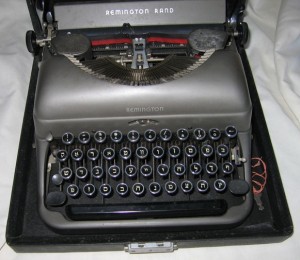 A point to consider about the typewriter: He would have used up a lot of ribbons typing that many pages. Ribbons are those inked strips of fabric that the metal characters hit to make the black or color impression on the white paper. This is something the computer generation doesn’t know anything about. The ribbons did not last all that long; the characters on the page got lighter as the ribbon was hit again and again; thus he would have been installing a new one with some regularity. As I recall, replacing the ribbon was not a very fun thing to do. Did he plan on writing day and night, and bring plenty of ribbons with him? Was he able to purchase more ribbons for his particular machine in Brazil?
A point to consider about the typewriter: He would have used up a lot of ribbons typing that many pages. Ribbons are those inked strips of fabric that the metal characters hit to make the black or color impression on the white paper. This is something the computer generation doesn’t know anything about. The ribbons did not last all that long; the characters on the page got lighter as the ribbon was hit again and again; thus he would have been installing a new one with some regularity. As I recall, replacing the ribbon was not a very fun thing to do. Did he plan on writing day and night, and bring plenty of ribbons with him? Was he able to purchase more ribbons for his particular machine in Brazil?
Another point about the typewriter brought up earlier by a reader: Was Wiesel a fast or slow typist? Many journalists were, and are, two-fingered (hunt and peck) typists because they never took typing classes. Where would Elie Wiesel have learned to type? In the newspaper office? If he was not a full-finger typist, it’s even less likely he could have churned out all those pages. Not to mention that these old typewriters did not allow the ease, and therefore speed, of our modern [computer] keyboard. These are practical questions that help us to ground ourselves in reality.
In addition, this manuscript is said to have been written in the style of a detailed history of the entire process of deportation, detention, people and places, punishments, liberation, yet Wiesel has no reference materials on board ship—only his memory. And since it was nine years since the events had ended, certainly some dulling of his memory had occurred. This simply could not be accomplished in the kind of mad rush Wiesel describes in All Rivers.
3. Wiesel’s motivation for attempting to write his concentration camp memories when he did is not given and is not apparent.
It’s astonishing that Wiesel gives only one paragraph in his memoir to the entire process of writing this book. He doesn’t write of thinking about it ahead of time. In fact, just at the time of his trip to Brazil he is carrying on a love affair in Paris, as well as being very busy, enthused and ambitious about his journalist assignments. Hanna, his love interest, had proposed marriage to him and he records in All Rivers that it “haunted me during the crossing,” during which time he “was worried sick that I might be making the greatest mistake of my life.”45 Yet, as though a kind of afterthought, he then tells us he spent the entire crossing holed up in his cabin, feverishly writing his very emotionally traumatic “witness” to the holocaust, even though only 9 years of his self-imposed 10-year vow of silence had passed.
In over 100 pages prior to the trip, Wiesel does not mention wanting to write about or even reflecting on his concentration camp year. The only explanation he includes in that paragraph is: “My vow of silence would soon be fulfilled; next year would mark the tenth anniversary of my liberation.”46 Then, just as suddenly, when he steps on land in Brazil, he is fully engaged in journalism and Hanna once again. He has given the typescript away and seems to have totally forgotten about it.
4. Wiesel had no opportunity to edit the 862 pages of And the World Remained Silent to the 245-page published version, yet he says he did.
Wiesel writes in All Rivers, “I had cut down the original manuscript from 862 pages to the 245 of the published Yiddish edition. French publisher Jerome Lindon edited La Nuit down to 178.”47 The time is 1957 and Wiesel is pleased a French publisher has been found for the manuscript he gave to Francois Mauriac—his French translation of Un di Velt Hot Gesvign, of which Wiesel says of the latter, “I had already pruned and abridged considerably.” The publisher, Lindon, now “proposed new cuts throughout, leading to significant differences in length among the successive versions.”
He repeats something similar in his Preface to the new 2006 translation of Night:
Though I made numerous cuts, the original Yiddish version still was long.48
He can only mean the 245-page book as the “original Yiddish version”—thus he “made cuts” from the longer version. But Wiesel could not have done it because he never saw the manuscript again after he supposedly gave it to Mark Turkov. He writes of his extremely busy life following the Brazil trip—covering world events as a journalist, spending time in Israel again before considering moving to NYC. He sounds underwhelmed when he reports receiving a copy of the Yiddish book in the mail from Turkov in Dec.1955, and devotes only a couple sentences to it. 49
Another time he refers to reducing the 245-page Yiddish version into a French version. Speaking of Mauriac:
He was the first person to read Night after I reworked it from the original Yiddish. 50
It is just these kinds of comments that cause the confusion remarked upon by Naomi Siedman in her essay commenting on Jewish rage in Wiesel’s first book. She writes that certain “scholars,” such as Ellen Fine and David Roskies give conflicting reports on the length of Wiesel’s original book, and it’s not clear just which book they are talking about. In my opinion, the reason for all the confusion is that they take Wiesel at his word as an honest witness … perhaps with some memory lapses. They won’t entertain the idea that this is part of a cover-up, the details of which Mr. Wiesel has a hard time keeping straight.
5. Wiesel’s recognized “style” and the style of the Yiddish book are noticeably different.
Not enough is known as yet to non-Yiddish readers like me about the content of Un di Velt Hot Gesvign to make the strongest case for the above statement, but a Jewish critic has provided some passages from the Yiddish book and I will quote from her (except for one passage from Joachim Neander). Naomi Siedman, in her long essay cited above, says this:
For the Yiddish reader, Eliezer Wiesel’s memoir was one among many, valuable for its contributing an account of what was certainly an unusual circumstance among East European Jews: their ignorance, as late as the spring of 1944, of the scale and nature of the Germans’ genocidal intentions. 51
In other words, holocaust narratives had already developed a “Yiddish genre” and the Wiesel memoir fit in with them. She explains:
When Un di velt had been published in 1956, it was volume 117 of Turkov’s series, which included more than a few Holocaust memoirs. The first pages of the Yiddish book provide a list of previous volumes (a remarkable number of them marked “Sold out”), and the book concludes with an advertisement/review for volumes 95-96 of the series, Jonas Turkov’s Extinguished Stars. In praising this memoir, the reviewer implicitly provides us with a glimpse of the conventions of the growing genre of Yiddish Holocaust memoir. Among the virtues of Turkov’s work, the reviewer writes, is its comprehensiveness, the thoroughness of its documentation not only of the genocide but also, of its victims.
[…]
Thus, whereas the first page of Night succinctly and picturesquely describes Sighet as “that little town in Transylvania where I spent my childhood,” Un di Velt introduces Sighet as “the most important city [shtot] and the one with the largest Jewish population in the province of Marmarosh,” and also “Until, the First World War, Sighet belonged to Austro-Hungary. Then it became part of Romania. In 1940, Hungary acquired it again.” 52
The Yiddish book has a different “feel” to it from Night; not only a different style, but a different personality is behind it. Ms. Seidman told E.J. Kessler, editor of The Forward:
The two stories can be reconciled in strict terms,” she said, “but they still give two totally different impressions, one of a person who’s desperate to speak versus one who’s reluctant.53
Here is a translation by Dr. Joachim Neander of a key passage in the Yiddish book, which he posted on the CODOH forum. It reveals an informal, talkative style, totally different from the spare, literary style used by Wiesel in all his books, even though the storyline is basically the same. Wiesel says he edited this book to its published form, but it doesn’t sound like him.
On January 15, my right foot began to swell. Probably from the cold. I felt horrible pain. I could not walk a few steps. I went to the hospital. The doctor examined the swollen foot and said: It must be operated. If you will wait longer, he said, your toes will have to be cut off and then the whole foot will have to be amputated. That was all I needed! Even in normal times, I was afraid of surgery. Because of the blood. Because of bodily pain. And now – under these circumstances! Indeed, we had really great doctors in the camp. The most famous specialists from Europe. But the means they had to their disposition were poor, miserable. The Germans were not interested in curing sick prisoners. Just the opposite.
If it had been dependent on me, I would not have agreed to the operation. I would have liked to wait. But it did not depend on me. I was not asked at all. The doctor decided to operate, and that was it. The choice was in his hands, not in mine. I really felt a little bit of joy in my heart that he had decided upon me.54
Back to Siedman’s translations. Two examples will have to suffice, from the Dedication and the very last paragraphs.
… while the French memoir is dedicated “in memory of my parents and of my little sister, Tsipora,” the Yiddish names both victims and perpetrators: “This book is dedicated to the eternal memory of my mother Sarah, father Shlomo, and my little sister Tsipora — who were killed by the German murderers.” 55
Now the book’s ending in the Yiddish version:
Three days after liberation I became very ill; food-poisoning. They took me to the hospital and the doctors said that I was gone. For two weeks I lay in the hospital between life and death. My situation grew worse from day to day.
One fine day I got up — with the last of my energy — and went over to the mirror that was hanging on the wall. I wanted to see myself. I had not seen myself since the ghetto. From the mirror a skeleton gazed out. Skin and bones. I saw the image of myself after my death. It was at that instant that the will to live was awakened. Without knowing why, I raised a balled-up fist and smashed the mirror, breaking the image that lived within it. And then — I fainted. From that moment on my health began to improve. I stayed in bed for a few more days, in the course of which I wrote the outline of the book you are holding in your hand, dear reader.
But — Now, ten years after Buchenwald, I see that the world is forgetting. Germany is a sovereign state, the German army has been reborn. The bestial sadist of Buchenwald, Ilsa Koch, is happily raising her children. War criminals stroll in the streets of Hamburg and Munich. The past has been erased. Forgotten. Germans and anti-Semites persuade the world that the story of the six million Jewish martyrs is a fantasy, and the naive world will probably believe them, if not today, then tomorrow or the next day.
So I thought it would be a good idea to publish a book based on the notes I wrote in Buchenwald. I am not so naive to believe that this book will change history or shake people’s beliefs. Books no longer have the power they once had. Those who were silent yesterday will also be silent tomorrow. I often ask myself, now, ten years after Buchenwald: Was it worth breaking that mirror? Was it worth it? 56
In contrast, Night ends with the gaze into the mirror at the very beginning of this passage. If the smashing of the mirror and the renewed will to live he felt from it was Elie Wiesel’s own experience, why would he leave it out in La Nuit? Because the publisher wanted it out? Not at all likely. Mauriac? Doubtful. It’s much more likely that it was not Elie Wiesel’s experience and it was not the kind of story he felt he could or wanted to tell.
Also note that the Yiddish writer says he wrote the outline of the book while still in the Buchenwald hospital, and that the published book is based on those notes. Elie Wiesel has never suggested that he began any writing in Buchenwald.
6. Wiesel wrote only one book in Yiddish; all subsequent books are in French.
If we could ask Elie Wiesel why he wrote his concentration camp memoirs in Yiddish, when he was already fluent and writing in French, we would probably get the answer he gave to his friend Jack Kolbert, who was writing a book about him:
“I wrote my first book, Night, in Yiddish, a tribute to the language of those communities that were killed. I began writing it in 1955. I felt I needed ten years to collect words and the silence in them.” 57
Alright. But we should also ask, just how good was Wiesel’s written Yiddish, that he could write this “enormous tome” in such a short time? After Nov. 29, 1947, Wiesel sought out and was given a job with the Irgun Yiddish weekly in Paris called Zion in Kamf. He tells how he was put to work translating Hebrew into Yiddish.
The task was far from easy. I read Hebrew well and spoke fluent Yiddish, but my Germanized written Yiddish wasn’t good. My style was dry and lifeless, and the meaning seemed to wander off into byways lined with dead trees. That was not surprising, since I was wholly ignorant of Yiddish grammar and its vast, rich literature.58
Even though he continued to translate and eventually write for the paper, he also spoke and wrote otherwise in French. He was attending classes at the Sorbonne and reading French classics and the newer existentialists. Following this first and only Yiddish book, Wiesel has done all his writing in French, by his own account—and in longhand, while the Yiddish was written on a typewriter.
It’s hard to reconcile Wiesel’s professed love of Yiddish 59 with his failure to do any writing beyond Un di Velt in that language. It’s suggested it is because Yiddish readers are a diminishing breed. No doubt, but that was already the case in 1954. For what it’s worth, Myklos Gruner records that when he met Elie Wiesel at their pre-arranged encounter in Stockholm in 1986, he asked Elie if he would like to speak in “Jewish,” and Elie said “no.” They ended up speaking together in English.60 Wiesel seems to have no interest in keeping the language alive.
7. Wiesel gives contradictory dates for the writing of his first book, and is fuzzy about what his “first book” is.
Wiesel makes it definite in All Rivers that he wrote the Yiddish book in the spring of 1954, in a cabin of a ship going to Brazil. But around the year 2000 he tells his friend Jack Kolbert:
It took me 10 years before I felt I was ready to do it. I wrote my first book, Night, in Yiddish, a tribute to the language of those communities that were killed. I began writing it in 1955. I felt I needed ten years to collect words and the silence in them. 61
So, is it 1954 or 1955? Wiesel says in All Rivers he met Francois Mauriac in May 1955, one year after his Brazil trip. Mauriac is often credited as the one who convinced Wiesel to end his silence, which culminated in Night. In his 1979 essay, “An Interview Unlike Any Other,” Wiesel writes:
Ten years of preparation, ten years of silence. It was thanks to Francois Mauriac that, released from my oath, I could begin to tell my story aloud. I owe him much, as do many other writers whose early efforts he encouraged. But in my case, something totally different and far more essential than literary encouragement was involved. That I should say what I had to say, that my voice be heard, was as important to him as it was to me.
[…]
(H)e urged me to write, in a display of trust that may have been meant to prove that it is sometimes given to men with nothing in common, not even suffering, to transcend themselves.62
He also wrote, in the same essay on the next page (17):
Paris 1954. As correspondent for the Israeli newspaper Yedioth Ahronoth, I was trying to move heaven and earth to obtain an interview with Pierre Mendes-France, who had just won his wager by ending the Indochina war. Unfortunately, he rarely granted interviews, choosing instead to reach the public with regular talks on the radio. Ignoring my explanations, my employer in Tel Aviv was bombarding me with progressively more insistent cabled reminders, forcing me to persevere, hoping for a miracle, but without much conviction. One day I had an idea. Knowing the admiration the Jewish Prime Minister bore the illustrious Catholic member of the Academie, why not ask the one to introduce me to the other? The occasion presented itself. I attended a reception at the Israeli Embassy. Francois Mauriac was there. Overcoming my almost pathological shyness, I approached him, and in the professional tone of a reporter, requested an interview. It was granted graciously and at once.
Wiesel continues the confusion around ’54 and ’55 when interviewed by the American Academy of Achievement on June 29, 1996 in Sun Valley, Idaho.63 In answer to the question “What persuaded you to break that silence?” he replied:
Oh, I knew ten years later I would do something. I had to tell the story. I was a young journalist in Paris. I wanted to meet the Prime Minister of France for my paper. He was, then, a Jew called Mendès-France. But he didn’t offer to see me. I had heard that the French author François Mauriac […] was his teacher. So I would go to Mauriac, the writer, and I would ask him to introduce me to Mendès-France. […]
Pierre Mendes-France became Prime Minister on June 18, 1954; his hold on that office ended on Jan. 20, 1955. Wiesel, according to his autobiography, had returned from Brazil, after writing and giving his 862-page Yiddish manuscript to Mark Turkov, expressly to cover the inauguration of France’s new Prime Minister for his Israeli newspaper.64 In this case, Wiesel’s first meeting with Mauriac had to be some time after mid-June 1954, since Mendes-France is already Prime Minister; it couldn’t have been in May or June 1955 because Mendes-France was long out of office. But in All Rivers, he puts his first Mauriac meeting in May 1955: “I first saw Mauriac in 1955 during an Independence Day celebration at the Israeli embassy.”(p.258) Israel’s Independence Day is May 14. Wiesel says the interview with Mauriac he obtained from that meeting resulted in his writing La Nuit and sending it to Mauriac one year later, in 1956. He continues describing that meeting to the Academy interviewer:
I closed my notebook and went to the elevator. He (Mauriac) ran after me. He pulled me back; he sat down in his chair, and I in mine, and he began weeping. […] And then, at the end, without saying anything, he simply said, “You know, maybe you should talk about it.”
He took me to the elevator and embraced me. And that year, the tenth year, I began writing my narrative. After it was translated from Yiddish into French, I sent it to him.
Wiesel says “the tenth year,” which would be 1955, but in the earlier part of the interview he is referring to 1954—because of Mendes-France. Snce he is mixing up the date, it’s no wonder we find the same mis-dating in stories about Wiesel’s life and accomplishments in books and on the Internet, including on Wikipedia pages.
Whenever it was that Wiesel had that fateful visit with Mauriac, he clearly did not mention that he had already written a very long Yiddish memoir, whether a year or a couple of months earlier. But had he written anything yet? Mauriac never alludes to a first Yiddish text. And as stated before, Wiesel himself didn’t either, until his 1995 memoir All Rivers Run to the Sea. This is truly noteworthy. Also, the title Un di Velt Hot Gesvign or, in English, And the World Remained Silent does not appear on the long list of “books by Elie Wiesel” at the beginning of All Rivers or the 2006 translation of Night.
To clarify an important problem Wiesel faces here: Wiesel, prior to 1990, claims to have first met and interviewed Mauriac in the spring of 1954 after returning from Brazil, but later changed it to May or June 1955. But even after that, he sometimes reverted to the 1954 scenario. When you are inventing all or parts of your life story, it’s difficult to keep it straight, especially when your guard is down.
A likely reason is his need to fit the writing and publication of the Yiddish book into his “schedule”, something he had not considered, or just ignored, previous to the Yiddish book being brought to the attention of the world by Myklos Grüner .
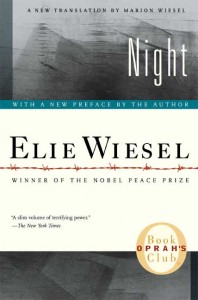
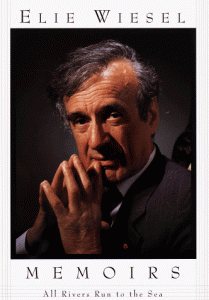
8. There are striking differences between Night, his “true story” derived from the Yiddish book, and his autobiography All Rivers Run to the Sea.
If Night is a true account of Wiesel’s holocaust experience, how to explain such major differences in the key passages that are compared below. In the first book it is his foot, in the latter his knee that is operated on right before the 1945 evacuation of Auschwitz.
Toward the middle of January, my right foot began to swell because of the cold. I was unable to put it on the ground. I went to have it examined. The doctor, a great Jewish doctor, a prisoner like ourselves, was quite definite: I must have an operation! If we waited, the toes—and perhaps the whole leg—would have to be amputated. .65
[…]
The doctor came to tell me that the operation would be the next day […] The operation lasted an hour.66
The doctor told him he would stay in the hospital for two weeks, until he was completely recovered. The sole of his foot had been full of pus; they just had to open the swelling. But, two days after his operation there was a rumor going round the camp that the Red Army was advancing on Buna. Not able to decide whether to stay in the hospital or join the evacuation, he left to look for his father.
“My wound was open and bleeding; the snow had grown red where I had trodden.” That night his “foot felt as if it were burning.” In the morning, he “tore up a blanket and wrapped my wounded foot in it.” 67
He and his father decided to leave. That night they marched out. They were forced to run much of the night and he ran on that foot, causing great pain. But after that he doesn’t mention it again. By contrast, in All Rivers, it is not his foot, but his knee that is operated on!
January 1945. Every January carried me back to that one. I was sick. My knee was swollen, and the pain turned my gait into a limp. […] That evening before roll call, I went to the KB. My father waited for me outside […] At last my turn came. A doctor glanced at my knee, touched it. I stifled a scream. “You need an operation,” he said. “Immediately.” […] One of the doctors, a tall, kind-looking man, tried to comfort me. “It won’t hurt, or not much anyway. Don’t worry, my boy, you’ll live.” He talked to me before the operation, and I heard him again when I woke up.” 68
[…]
January 18, 1945. The Red Army is a few kilometers from Auschwitz. […] My father came to see me in the hospital. I told him the patients would be allowed to stay in the KB […] and he could stay with me […] but, finally, we decided to leave with the others, especially since most of the doctors were being evacuated too.69
No further mention of the knee. How can we account for this bizarre change from foot to knee? It seems that as weak as Wiesel presents himself to be at Buna, he could not himself believe that he could run around on a foot that had just been operated on for pus in the sole, with no protection. So he simply changed it to his knee.
The next passage is after the liberation of Buchenwald on April 11, 1945. In Night:
Our first act as free men was to throw ourselves onto the provisions. We thought only of that. Not of revenge, not of our families. Nothing but bread.
And even when we were no longer hungry, there was still no one who thought of revenge. On the following day, some of the young men went to Weimar to get some potatoes and clothes—and to sleep with girls. But of revenge, not a sign.
Three days after the liberation of Buchenwald I became very ill with food poisoning. I was transferred to the hospital and spent two weeks between life and death.70
In All Rivers, Wiesel changes the story. He writes:
A soldier threw us some cans of food. I caught one and opened it. It was lard, but I didn’t know that.71 Unbearably hungry—I had not eaten since April 5—I stared at the can and was about to taste its contents, but just as my tongue touched it I lost consciousness.
I spent several days in the hospital (the former SS hospital) in a semiconscious state. When I was discharged, I felt drained. It took all my mental resources to figure out where I was. I knew my father was dead. My mother was probably dead ….. 72
From two weeks to only several days spent in the hospital. Could this change have anything to do with the famous “Buchenwald survivor” photograph73 that Elie discovered himself in sometime after 1980, when he was actively seeking a Nobel Prize? If he were in the hospital “between life and death” for two weeks following April 14 or so, he could not be in that photograph taken on April 16. The author of And the World Remained Silent, whoever he is, never claimed to be in that photograph.
9. Elie Wiesel refuses to back up his authorship by showing his tattoo.
If Elie Wiesel is the man who wrote Un di Velt Hot Gesvign, the source of the world-famous Night—the same man who wrote about receiving the tattoo number A7713 at Auschwitz in 1944—why won’t he show us this tattoo on his arm? And why do we see video of his left forearm with no tattoo visible at all? Wiesel could so easily clear up this problem, but he doesn’t choose to do so.
Endnotes:
38) Elie Wiesel, A Jew Today, Vintage Books, 1979, 260 pg.
39) http://worldsgreatestenglishclass.com/media/ww2/19EWSpeech.pdf
40) Stolen Identity, p. 50
41) Ibid, p. 43. Grüner mentions the 862 pages twice, but not with proof of their existence. “… Lazar Wiesel’s manuscript […] tell us his story and covers his survival of the Holocaust in 862 pages.” Also, “… had to use Lazar’s false identity in Paris and his existing manuscript of 862 pages …”
42) All Rivers, p. 277. “In December (1955) I received from Buenos Aires the first copy of my Yiddish testimony And the World Stayed Silent,” which I had finished on the boat to Brazil.”
43) Ibid.
44) http://rapidshare.com/files/441835370/Elie-Wiesel-Night-Yiddish.pdf
45) All Rivers, p. 239
46) Ibid, p. 240
47) Ibid, p. 319
48) Night, p. x
49) All Rivers, p. 277
50) Ibid. p. 267
51) Siedman, “Jewish Rage”
52) Ibid.
53) “The Rage that Elie Wiesel Edited Out of Night,” E.J. Kessler, ‘The Forward‘, October 4, 1996
54) http://forum.codoh.com/viewtopic.php?f=2&t=6146
55) Siedman, “Jewish Rage,” (trans. from Un di Velt)
56) Ibid. (Un di Velt, 244-45)
57) Jack Kolbert, The Worlds of Elie Wiesel: An Overview of His Career and His Major Themes, Susquehanna University Press, Selinsgrove, PA, 2001, p. 29
58) All Rivers, p.163
59) Ibid. p.291-92
60) Stolen Identity, p.31
61) Kolbert, p. 29
62) “An Interview Unlike Any Other,” Elie Wiesel, A Jew Today, trans. Marion Wiesel (New York, 1979), p.16
63) http://www.achievement.org/autodoc/page/wie0int-3
64) All Rivers, p. 242: “I had been away for two months when Dov recalled me to Paris to cover Pierre Mendes-France’s accession to power. I flew back …” This had to be in June 1954.
65) Night, p.82
66) Ibid. p.83
67) Ibid. p.87
68) All Rivers, p.89-90
69) Ibid. p.91
70) Night, p.115-16
71) Why would soldiers throw cans of lard? Sounds terribly disorganized and irregular. How did he open the can? If he didn’t know it was lard, and lost consciousness before he tasted it, we must assume someone in the hospital told him after he regained consciousness that he had been holding a can of lard when he was brought in. Either that or it’s just made up.
72) All Rivers, p.97
73) http://www.eliewieseltattoo.com/buchenwald
8 Comments
Category Featured | Tags: Tags: All Rivers Run to the Sea, Brazil, Buchenwald liberation, Francois Mauriac, knee/foot operation, Mark Turkov, Mendes-France, Miklos Grüner, Naomi Siedman, Night, Yedioth Ahronoth, Yiddish typewriter,
Social Networks: Facebook, Twitter, Google Bookmarks, del.icio.us, StumbleUpon, Digg, Reddit, Posterous.
 by Carolyn Yeager
by Carolyn Yeager 7. Photo of Buchenwald Boys (scroll down a bit). The boy that Ken Waltzer has identified as Elie Wiesel (who was identified to him as such by Jack Werber of Great Neck, NY, a “holocaust survivor” activist) is clearly not Wiesel and has not been identified as Wiesel by anyone other than Ken Waltzer. Waltzer had this image/blurb, at right, on his MSU website for years [the site was removed sometime in 2012], making him look foolish. Will Waltzer admit that he was wrong all this time, or try to sweep it under the proverbial rug?
7. Photo of Buchenwald Boys (scroll down a bit). The boy that Ken Waltzer has identified as Elie Wiesel (who was identified to him as such by Jack Werber of Great Neck, NY, a “holocaust survivor” activist) is clearly not Wiesel and has not been identified as Wiesel by anyone other than Ken Waltzer. Waltzer had this image/blurb, at right, on his MSU website for years [the site was removed sometime in 2012], making him look foolish. Will Waltzer admit that he was wrong all this time, or try to sweep it under the proverbial rug? 2. The Questionaire [scroll down page] was apparently prepared for and signed by every prisoner prior to their release. It is dated April 22, 1945; the prisoner number is 123165, different by one digit from our previous Lazar Wiesel #123565, and is the number belonging to a recently deceased inmate, Pavel Kun,5 whose death is recorded as March 8, 1945. Since Elie Wiesel allegedly received his number upon arrival on Jan. 26, 1945, he would not later be given a new number from a prisoner who just died. It would seem from this that Lázár Wiesel is a newcomer-of-sorts who had been given a number that had just been released.
2. The Questionaire [scroll down page] was apparently prepared for and signed by every prisoner prior to their release. It is dated April 22, 1945; the prisoner number is 123165, different by one digit from our previous Lazar Wiesel #123565, and is the number belonging to a recently deceased inmate, Pavel Kun,5 whose death is recorded as March 8, 1945. Since Elie Wiesel allegedly received his number upon arrival on Jan. 26, 1945, he would not later be given a new number from a prisoner who just died. It would seem from this that Lázár Wiesel is a newcomer-of-sorts who had been given a number that had just been released. This registration card is the only item that casts some doubt7 over Nikolaus Grüner’s account of Lazar and Abram. But it does not prove that this Lazar Wiesel is Elie Wiesel. It does not make any sense that all the birth dates for the same person would be different! It makes more sense that there were several persons with similar names.
This registration card is the only item that casts some doubt7 over Nikolaus Grüner’s account of Lazar and Abram. But it does not prove that this Lazar Wiesel is Elie Wiesel. It does not make any sense that all the birth dates for the same person would be different! It makes more sense that there were several persons with similar names.
























